

Lenskart Case Study: Business, Marketing Strategy & Success Story

Today, every 3rd person of the total Indian population needs spectacles. The growth of technology has led to the increased use of laptops. A sedentary working style and constant gazing at the laptop screens have led to many eye problems. Some of them are:
- Hyperopia (farsightedness,i.e. difficulty in seeing close objects)
- Myopia (nearsightedness, i.e. difficulty in seeing far objects)
- Astigmatism (blurred distant or near objects)
- Presbyopia (gradual decrease in visibility of near objects in 40+age group)
- Frequent headaches, and others.
All these are medical conditions related to poor visibility. So good glasses have become an essential commodity.
The eyewear industry of India:
The struggle begins for a person to get involved in physical shopping for glasses. It requires a lot of patience and time to visit an optician. You need to get your eyes tested and select an apt frame for the glasses. Also, wait a long time to receive the selected eyewear. To sum up, eyewear has become a need for some and a fashion element for some. So the sale of eyewear has increased over the past few years. Every day approximately 15 lacs spectacles are being sold in the Indian market . The eyewear industry saw a revolutionary new turn in 2010, with the emergence of Lenskart.
Establishment:
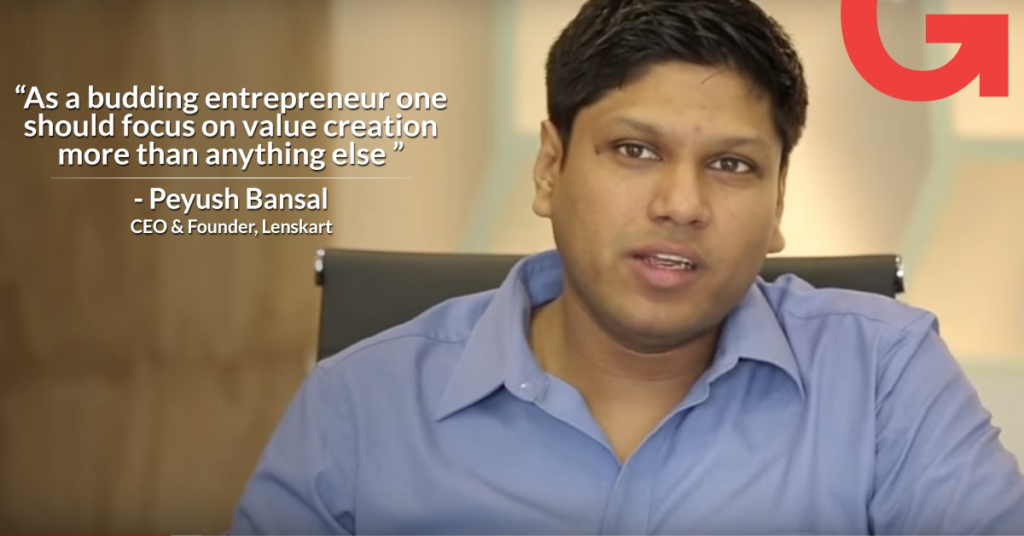
Lenskart is a Faridabad based optical prescription eyewear retail chain. Founded by Peyush Bansal in 2010. It revolutionized the unorganized eyewear industry of India. The founders focus on three main pre-existing problems of the Indian eyewear industry:
- Eyewear was being considered medical equipment and the wearer did not feel good about wearing it
- Branded eyewear had higher prices starting from Rs. 1500.
- People had very low accessibility to opticals in India.
The company has launched the widest range of eyewear products. Like contact lenses, prescription glasses, sunglasses, anti-glare glasses, try-at-home glasses, and many more. It has marked its presence offline by having 550+ kiosks across various states of India.
Lenskart’s mission is to become the “Maruti Suzuki” of the Indian eyewear industry. The company has emerged as one of the best e-commerce companies. It has online as well as offline distribution mediums. Lenskart earned the “Unicorn Company Status” at the end of 2019.
Lenskart is the first and the only Indian brand that uses robotic technology to deliver specs that are accurate to 3 decimal places. The brand also delivers services like 3D Try On and Home Eye Check-Up. The manufacturing plant of Lenskart lies in Rajasthan.
About Lenskart:
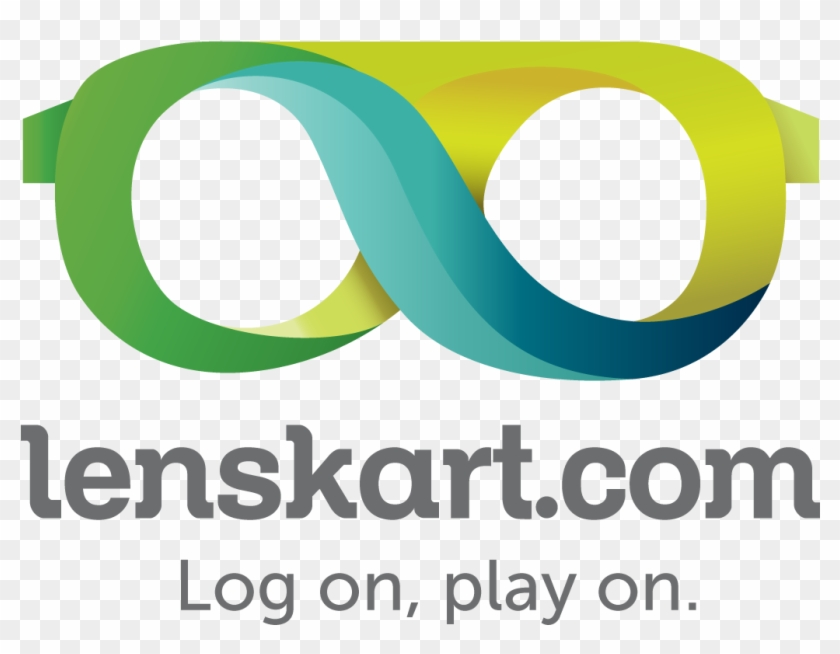
Peyush Bansal: Born on 26th April 1985, he holds a Bachelor’s degree in the branch of Electrical Engineering, IT, Control & Automation from McGill University, Canada. On completion of his graduation in 2006, he pursued his PGD in entrepreneurship from IIM (Indian Institute of Management), Bengaluru. Soon after completion of his PG, he joined Microsoft as a programming manager in the USA. He served there for around 11 months then returned to India to pursue his dream of becoming an entrepreneur. He launched around 5 companies before the launch of Lenskart.
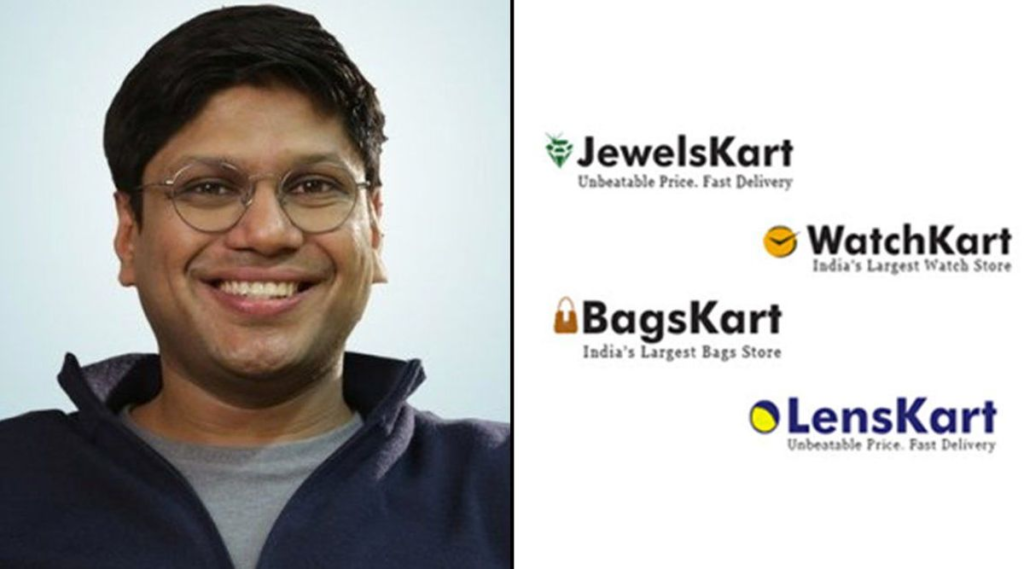
During his IIM days, he launched his own company Valyoo Technologies in 2007. He launched a campaign under the name “SearchMyCampus” with Rs. 25,00,000 investment, which was a great hit. It was a classified online portal for students to solve their problems. Like finding part-time jobs, carpool facilities, internship offers coaching books, etc.
During his exploration, he found the eyewear segment running very poor. He then launched an online store “Flyrr.com” in June 2009. It sold contact lenses, sunglasses, etc. This store was focused on the US market then he decided to replicate the same model in India and launched Lenskart in 2010.
In May 2011, Peyush Bansal launched “Watchkart.com” to sell premium watches from top-notch brands, like Tommy Hilfiger, Fossil, Emporio Armani, Casio, Fastrack, and others. The website displayed classy and exuberant watches and gained a lot of traction.
Bagkart.com was launched in August 2011 under Valyoo Technologies. The website sold a wide range of handbags.
Peyush Bansal launched another vertical in the name “JwelsKart.com”, with his three existing verticals Lenskart, WatchKart, and BagsKart, It sold jewelry of all kinds.
The company found that among all the verticals, Lenskart was performing much better. Due to low traction and a fall in revenue, Peyush Bansal had to shut down Watchkart, Bagskart, and Jewelskart in 2015. He could thus follow only on Lenskart.
Neha Bansal: She is another co-founder of Lenskart. She had served as a partner at Vinod Kumar and Associates before being in Lenskart.
Amit Chaudhary: Co-founder of Lenskart, Amit Chaudhary is a Computer Science Engineer from BITs Mesra, Ranchi. He has a passion for traveling to different places. Belonging to Kolkata, he did his schooling at Bharatiya Vidya Bhavan school. His deep understanding of technology and innovative ideas has led to revolutionary changes in the business.

Sumeet Kapahi: A student of Delhi University, Sumeet Kapahi was a business development manager of Luxottica India Eyewear (Rayban), before joining as one of the co-founders of Lenskart.

Revenue and funding:
Peyush Bansal founded Lenskart in 2010 along with his two friends Amit Chaudhary and Sumeet Kapahi. The financial backers of the company are TPG Growth, International Finance Corporation, Adveq Management, Ratan Tata , Kris Gopalakrishnan, Kedaara Capital, Chiratae Ventures, Rajeev Chitrabhanu, Eqip Capital, and IFC Venture Capital Group are investors in the company.

- 2017: Lenskart launched the international eyewear brand, John Jacobs.
- Katrina Kaif got launched as the first brand ambassador of the brand.
- 2018: Wipro Chairman Azim Premji invested INR 4 crore in the company. It increased the total valuation of the company to Rs. 3000 crores.
- 2019: Lenskart launched Bhuvan Bam as its first male brand ambassador.
- 2020: Lenskart generated total revenue of Rs.1,000+ crore
Business & marketing strategy of Lenskart:
- Inventory-based business model – Lenskart offers 5,000+ designs of frames and 45+ different quality lenses for its customers. The company passes on the designs to its manufacturers. While developing the products, the company focuses on superior quality, durability, wide range, innovativeness, and services like a 3-D testing facility. It uses German imported robotic technology, which has made Lenskart the only Indian brand to make eyewear with an accuracy of up to 3-decimals.

- Advertising on Google – Google ads are the most powerful strategies for businesses in today’s digital era. Lenskart uses this method and invests in paid advertising on Google. It uses popular keywords like eyeglasses, sunglasses, frames, and computer glasses. It also promotes its products through overpaid Google Shopping ads, where the viewer can themselves take an action. Lenskart uses Google ads through display ads, video ads, app download ads, and others.
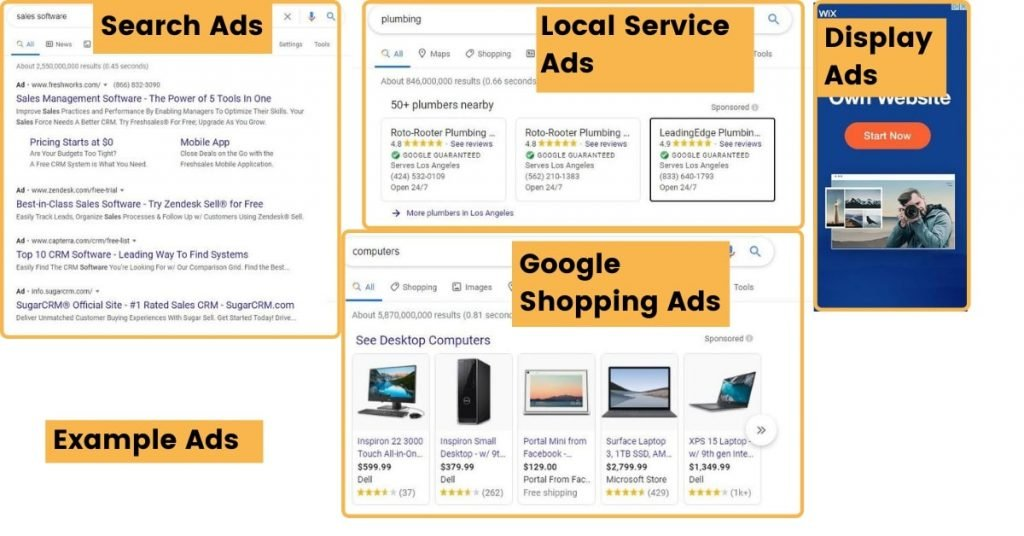
- Social Media Campaign – They run Facebook and Instagram ads to advertise their products. Lenskart also uses conventional advertisements, like newspaper ads, television ads, email marketing , and others. All these tin steps have made the brand emerge as a well-recognized eyewear brand in India.
- Omni-channel retail business model – The company observed the Indian mindsets and found that people are apprehensive about buying eyewear products online. Thus it focussed on establishing brick and mortar stores in India. The company offers services in both online and offline modes. It now has 550+ stores across 30+ cities.

- SEO – Lenskart website is well optimized to be user-friendly. The website has a strong SEO and gets 1.8 million visitors per month.
- Focus on quality and price- Lenskart saw the existing problems in the Indian market. It focussed on launching innovative and cost-effective products without compromising on their quality. “Lenskart Blu” is one of their innovative products that protect the eyes from harmful UV rays. It also offers a wide range of unbreakable, ultra-light, and super-flexible frames in the name of “Airflex”.

- Celebrity endorsements- The products of Lenskart are not an eyesight cure. But also create a style statement for the user. Thus the brand endorses popular personalities to attract the young mass. The first brand ambassador of Lenskart was Katrina Kaif followed by Bhuvan Bam. The brand is associated with popular premium brands, like Ray-Ban, Vogue, John Jacobs, and others. This facilitates the customers to get access to a wide range of premium products under one roof.

- Franchising for offline stores- In 2014, Lenskart ventured into offline stores to promote its products. It adopted the franchise model to serve people all over India. It now has 720+ stores across India and has plans to expand further. The franchise business model enhanced the online presence of Lenskart with minimal investment. During the covid-19 pandemic, most businesses had to shut down their stores. And turn into online mode. But Lenskart took a brave step by opening up 300+ stores making a total of 1000 stores. Lenskart focuses on reaching out to more customers through its offline stores.
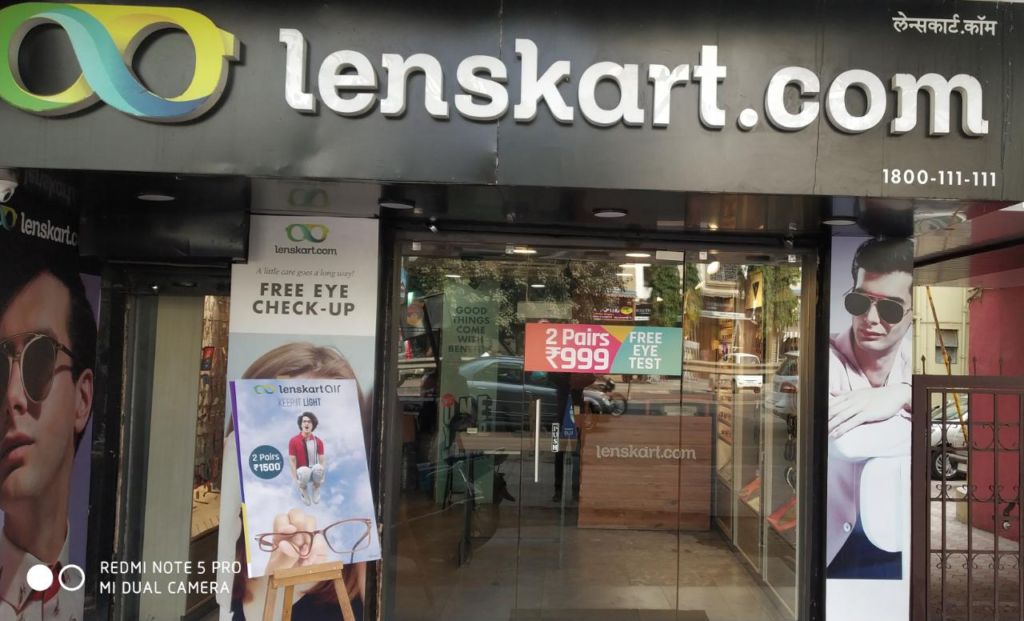
- Virtual reality technique- Lenskart offers a real-time experience to its customers through its app. The brand launched for the first time a 3-D try-on feature by collaborating with a start-up in California named Ditto. The feature offered the customer to try any frame in virtual reality. Peyush Bansal found this feature to be a very effective marketing strategy . As it brought around 15,000 customers every day to the Lenskart platform.

- B2C model- B2C refers to Business-to-Customer. It is an e-commerce strategy that eliminates the middlemen to sell the products. Lenskart uses this technique to sell its products through its websites and its mobile app. The B2C model has helped the brand make its products affordable for all. It collects customer feedback to understand their marketing behavior. Lenskart has collaborated with many logistics companies, like BlueDart, Delhivery, etc. for quick delivery services. It ensures timely and safe delivery of its products to the customers.

- Modern eye-testing- Lenskart offers advanced technology eye testing to its customers In stores as well as at their homes. The equipment used for eye testing gets imported from the USA, which is more efficient than the conventional tools and equipment used in India. The customer has to book an appointment for eye testing and an apt optometrist will visit their house to carry out the testing process.
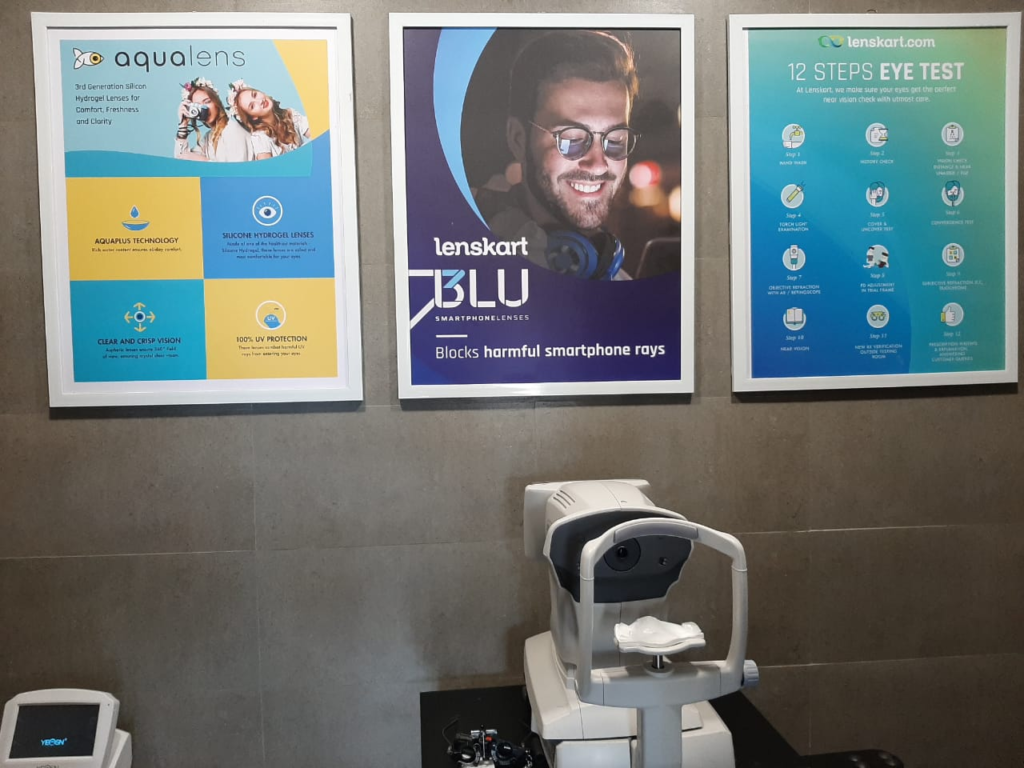
- Attractive discounts- Lenskart has studied the Indian mindsets and has understood that our local customers get fascinated with discount offers. The brand thus offers exciting discount offers and schemes. They offer discounts like free eye check-ups, offering the first frame free of cost to the new customer, and others. The home testing facility is an exciting offer in itself. The eyewear specialist carries with him the 100 most popular frames for the customers to try on at their homes. These offers and discounts have proved to be one of the best marketing strategies and have gained a lot of customers to the platform.

Brand ambassadors:
Katrina kaif- Lenskart appointed the famous Bollywood star Katrina Kaif in October 2017 as its first brand ambassador. Peyush Bansal said that the reason behind choosing Katrina Kaif as the brand ambassador was her playful attitude. As the brand is all about fun, fashion, and playfulness.

Bhuvan Bam- Lenskart appointed Youtube sensation Bhuvan Bam as its next brand ambassador in March 2019. Founders explained that the digital content of Bhuvan Bam is appealing to the youth and so he can help the brand gather more audiences.
Competition analysis of Lenskart:
In the herd of eye care industries, Lenskart has stood out among other online and offline competitors popular brands like GKB, Lawrence, and Mayo, Titan Eye Plus, Bausch + Lomb, Specsmakers, and Coolwinks are among the offline competitors of Lenskart, and Flipkart, Amazon, and Snapdeal are among the online competitors. Ray-Ban and Essilor are such brands that have a strong presence on online as well as offline platforms. Lenskart incorporates unique marketing strategies. Differential price points and innovative technologies make a strong presence in the eyewear industry. The products of Lenskart are affordable and long-lasting, targeting customers of different segments. The range of products starts from Rs. 345 up to Rs. 30,000.
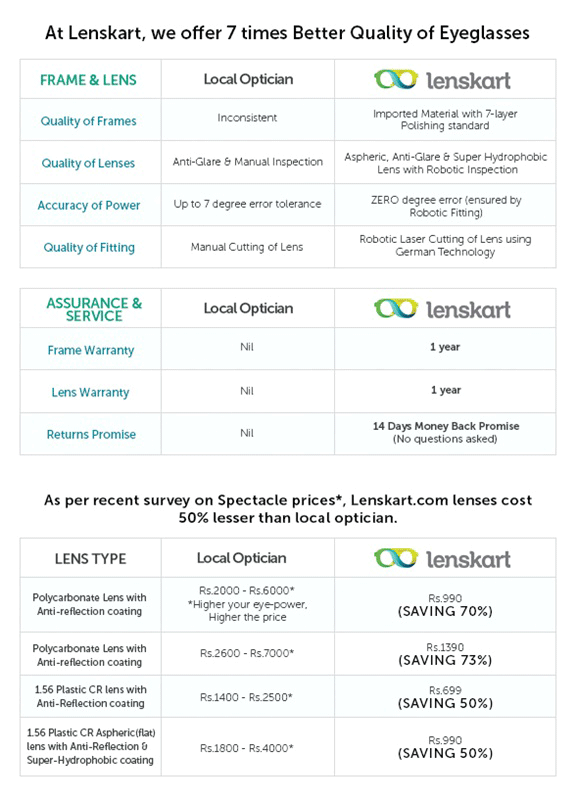
Range of products and services offered by Lenskart:
- “First frame is free” offer- Lenskart offers its customers to pay only for the lens on their first buy. And get the second frame for free.
- Eye checkup at home- The band introduced a home eye testing facility for the customers. Where an optometrist would visit the house of the customers to conduct the testing.
- “Try at home”- Lenskart allows a customer to choose up to 5 frames and try them at home before finally making a buy.
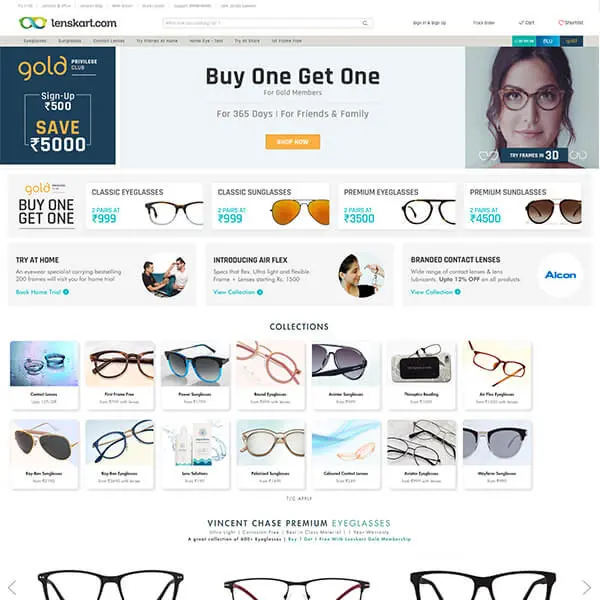
- Lenskart Blur (launched in 2019)- Eyewear solution to block harmful blue light rays. What emerges out of mobile and computer screens. It intends to avoid severe damage to the eyes due to such rays.
- Innovative techniques- First time in India, Lenskart introduced a 3D facial visualizer. Through this, a customer can see how the frame looks on him, before finally purchasing it.
- Wide range of products- Lenskart offers a huge range of products. Like sunglasses, premium eyeglasses, and glasses of different shapes (Wayfarer, oval, rounders, cat eye, etc.), Branded lenses (Ray-Ban, Johnson & Johnson), contact lenses, and others.
- Allows customers to replace their old glasses with new pairs of glasses.
- Live customer support help.
Winding up:
Lenskart has emerged as one of the top startups in India due to its unique marketing strategies and got listed among the “ Top 10 promising e-commerce Indian startups in 2021 ” by the Indian Wire. The brand has reached a million hearts by providing the best eyewear solutions to people. It blends conventional methods with modern ones with a touch of the latest technologies. The goals of the company revolutionized the eyewear industry in India. The company has generated huge employment opportunities in the country through manufacturing and retailing processes.

Suraj Shrivastava
Suraj Shrivastava at ForgeFusion shares simple, effective ways to grow your business using SEO, content marketing, and AI, learned from helping over 50 companies. When he’s not working, he loves teaching others or watching documentaries.
4 thoughts on “Lenskart Case Study: Business, Marketing Strategy & Success Story”
Is Lenskart Case Study downloadable free for me.
thanks for this marketing us very good and nice
interesting..
Lenskart’s focus on technology has been a key factor in its success. The company’s proprietary 3D eye scanner and virtual try-on technology have made it possible for customers to get accurate prescriptions, find the right fitting glasses, and visualize how the glasses would look on them without ever having to leave their homes. This has helped Lenskart to overcome the traditional challenges of online eyewear retailing and attract a large number of customers
Leave a comment Cancel reply
Save my name, email, and website in this browser for the next time I comment.

A Case Study on Lenskart
Apr 25, 2022
50 likes | 114 Views
Lenskart is planning to start technology in a few years & invest more than $2 million that will include providing the glasses instantly on the spot.
Share Presentation

Presentation Transcript
A Case Study on Lenskart By Josie Patra September 15, 2021 Image Source- Flickr Article Overview Introduction: The change begins About Lenskart Company and its unique approach Removing the barriers to business Gaining the trust of consumers
Expanding the reach A Sales oriented business model Enhanced convenience for customers Evidence of customer trust History Growth and Features: The business model: Conclusion: Further Reading Introduction: The dramatic entry of Lenskart into the Indian eyewear industry landscape signaled a paradigm shift in conducting the business with complete reliance on the brick and mortar stores. 2010 is a milestone in the history of the Indian eyewear industry as it gave consumers more convenient options for buying eyewear products online. Until the end of the first decade of the new millennium, the optical business in India firmly held on to the traditional business model of conducting business through brick and mortar stores only. One had to visit an optical store or any other retail shop that sold eyewear products for buying spectacle frames and lenses, contact lenses and sunglasses. Most optical stores provided the service of eye checkups for the convenience of customers, which also helped attract new customers. Although the E-commerce business was fast gaining traction during this time and online shopping was fast catching up, it focused mainly on household items and appliances, groceries, food and supplies, clothing, footwear, jewelry, electronics, toys and games, smartphones, and digital gadgets and many more. Sunglasses were perhaps the only eyewear that was available online. However, one had to visit a physical store to buy spectacles and contact lenses.
You can read the full content: https://businessupside.com/2021/09/15/a- case-study-on-lenskart/ •••••••••••••••••••••••••• Business Upside Email ID: [email protected] Phone No.: +1-425-605-0775 Visit Us: https://www.businessupside.com/ Stay Connected Via: https://www.facebook.com/businessupside https://www.youtube.com/channel/UCuSkeS5oU- B2tRIBDYntmaw https://twitter.com/BusinessUpside1
- More by User

A CASE STUDY.
THE ROLE OF SCIENCE, TECHNOLOGY AND INNOVATION TO INCREASE COMPETITIVENESS IN THE PRODUCTIVE SECTOR: THE JAMAICAN EXPERIENCE OF WALKERSWOOD. A CASE STUDY.
600 views • 12 slides

A Case Study
Environmental Inquiry Nature of Science A Case Study Acid Rain and Environmental Toxins: Toxicity Testing Using Bioassays Introduction
727 views • 18 slides

Program Management Methodologies and Practices in the Aegis Program Office and Its Impact on Systems Engineering, Naval Surface Warfare Center, Dahlgren Division (NSWCDD), Dahlgren, VA. Evolution of Enterprise Program Management. A Case Study. October 2003. Authors.
490 views • 20 slides

A case study:
A case study:. A Comparative Study of Nature Images in Chinese and English Poems. Introduction of the topic “ image ”. Cuckoo in Chinese poems.
465 views • 29 slides

A CASE STUDY
A CASE STUDY. MARK PENDOLINO. INTERACTIVE MEDIA MARKETING. A Look at the new Commercial Movement. Interactive Media Marketing. A CASE STUDY. MARK PENDOLINO. AGENDA. Introduction / Background Definitions Online Advertising Resurgence Burger King’s New Creative
451 views • 25 slides

A Case Study. CSCI397c OODBMS Fall ’99 by William Yeo. Outline. Introduction GemStone Overview GemStone Data Model References. Introduction. Modern application needs modern architecture. Multi-User Object Server Programmable Object Server
340 views • 20 slides

a case study
System to Software Integrity. a case study. Matteo Bordin Jérôme Hugues Cyrille Comar , Ed Falis , Franco Gasperoni , Yannick Moy, Elie Richa. How to verify property preservation?. Peer review. Testing. Design/Verify-by-contract (Eiffel, Ada 2012, SPARK, Frama -C, …).
217 views • 13 slides

A Case Study on Enterprise Architecture
A Case Study on Enterprise Architecture. Syngenta: A global agribusiness. Syngenta: Background. Formed by a merger between Novartis and AstraZeneca in 2000 20,000 end users in 420 site around the world
681 views • 23 slides

A Case Study on Covalent Bonding
A Case Study on Covalent Bonding. By: Wong Wei Cong (31) 2A1. What is Covalent Bonding. What is Covalent Bonding . Sharing of electrons so as to achieve stable electronic configuration of noble gas Electrostatic attraction between nuclei of the atoms and the pair(s) of shared electrons
653 views • 22 slides

A Case Study. Resolving Conflict- PNC Infratech JV . Customer- PNC Infratech. Important Customer- Executing projects all over India MPSO- POL Business 60 TMT (Bitumen, HSD, FO) 3 Projects in MPSO Ratlam Gwalior Airport Morena-Dholpur MOU for 3 Projects wef Sep-2009 for 30 months
213 views • 8 slides

A CASE STUDY ON OWS- ABUSE!!
A CASE STUDY ON OWS- ABUSE!!. NARRATIVE.
444 views • 33 slides

A case study
A case study. The following data come from an experiment designed to measure the accuracy of eleven laboratories. Each laboratory was given three samples for each of two different types of chalk. The laboratories were then asked to take readings on the bulk density of precipitated chalk.
269 views • 17 slides

A Case Study on Pride
Nebuchadnezzar Daniel 2-4. A Case Study on Pride. INTRODUCTION…. 1. Pride is something we all struggle with! Rom 12:3 2. This attitude has NO PLACE in the Christian Character! Rom 8:29. INTRODUCTION…. 1. Pride is something we all struggle with! Rom 12:3
520 views • 23 slides

A Case Study. Some Advice on How to Go about Solving Problems in Prolog A Program to Play Connect-4 Game. Some Advice on How to Go about Solving Problems in Prolog. 1. Have a very clear understanding of the problem what are the initial conditions? what is the goal state?
228 views • 10 slides

A Case Study. PRESENTED BY: TED, TIFFANY & JORDAN. Intro/Summary - Who is the Protagonist?. Google is the world’s leading search engine
255 views • 15 slides

A Case Study…
A Case Study…. Variable Data Print, Verification & Interface System. Business Problem. Overview Major Pharmaceutical company has multiple Production Lines under performing... Inadequate performance and reliability with current Printing Solution Business Impact
285 views • 15 slides

A Case Study. Jake Blanchard Spring 2008. How do we really use FEM?. The use of FEA is really more complicated than we have made it. The complication lies in converting a real structure into a numerical model. What are loads? What are boundary conditions? What features can we ignore? Etc.
252 views • 13 slides

A Case Study. Jake Blanchard Spring 2010. Introduction. These slides contain a description of a case study of an uncertainty analysis You should use this as a model for your final projects. The Case. We are concerned with widget production
531 views • 23 slides

A case study. Investigation: What causes colon cancer? What is the effect of diet on colon cancer?. Observational studies. 1971 Dr. Denis Burkitt, British surgeon, studies disease patterns in poor, rural, African sites Rural Africans: Much less colon cancer, diet rich in higher fiber
274 views • 13 slides

A CASE STUDY. Section 3. Overview In this section we will show the negative consequences of the lack of coordination in a large scale machine We analyze the behavior of a complex scientific application representative of the ASCI workload on a large scale supercomputer
596 views • 42 slides
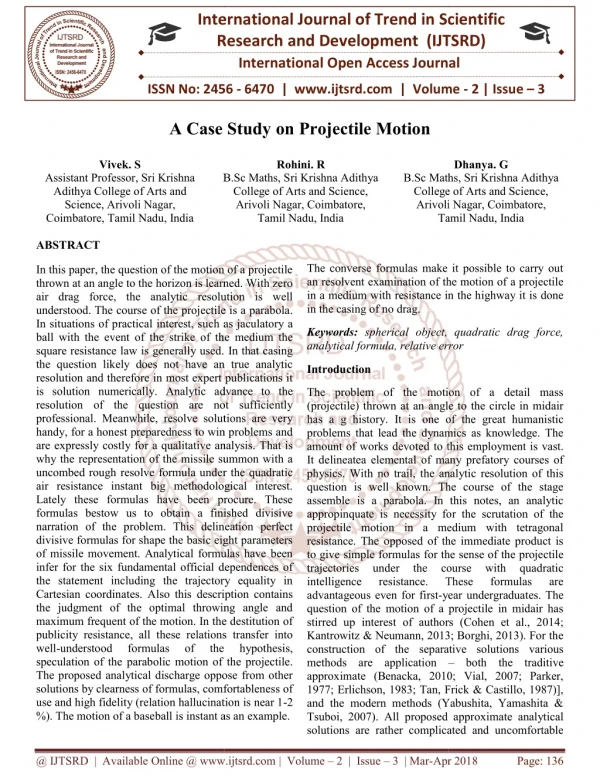
A Case Study on Projectile Motion
In this paper, the question of the motion of a projectile thrown at an angle to the horizon is learned. With zero air drag force, the analytic resolution is well understood. The course of the projectile is a parabola. In situations of practical interest, such as jaculatory a ball with the event of the strike of the medium the square resistance law is generally used. In that casing the question likely does not have an true analytic resolution and therefore in most expert publications it is solution numerically. Analytic advance to the resolution of the question are not sufficiently professional. Meanwhile, resolve solutions are very handy, for a honest preparedness to win problems and are expressly costly for a qualitative analysis. That is why the representation of the missile summon with a uncombed rough resolve formula under the quadratic air resistance instant big methodological interest. Lately these formulas have been procure. These formulas bestow us to obtain a finished divisive narration of the problem. This delineation perfect divisive formulas for shape the basic eight parameters of missile movement. Analytical formulas have been infer for the six fundamental official dependences of the statement including the trajectory equality in Cartesian coordinates. Also this description contains the judgment of the optimal throwing angle and maximum frequent of the motion. In the destitution of publicity resistance, all these relations transfer into well understood formulas of the hypothesis, speculation of the parabolic motion of the projectile. The proposed analytical discharge oppose from other solutions by clearness of formulas, comfortableness of use and high fidelity relation hallucination is near 1 2 . The motion of a baseball is instant as an example. The converse formulas make it possible to carry out an resolvent examination of the motion of a projectile in a medium with resistance in the highway it is done in the casing of no drag. Vivek. S | Rohini. R | Dhanya. G "A Case Study on Projectile Motion" Published in International Journal of Trend in Scientific Research and Development (ijtsrd), ISSN: 2456-6470, Volume-2 | Issue-3 , April 2018, URL: https://www.ijtsrd.com/papers/ijtsrd10839.pdf Paper URL: http://www.ijtsrd.com/physics/mathematical-physics/10839/a-case-study-on-projectile-motion/vivek-s
68 views • 6 slides

A Case Study on Blackout
Indian grid system is a synchronized system and presently operating as National Grid. India has five provincial grids altogether as per geological region which covers the distinct states electrical power framework to be specific these are Northern Grid, Eastern Grid, Western Grid, Southern Grid and North Eastern Grid. Southern Grid isnt synchronized with whatever is left of the areas and consequently keeps running on a marginally different frequency and associated with Western Grid and Eastern Grid through HVDC links. A power outage is the total or partial loss of energy to a territory and is the most serious type of blackout that can happen. Power outage is a transgression to the interconnected power framework. At the point when interconnected power framework goes out of step, it is basic and essential to distinguish it quickly, and islanding ought to be taken to counteract boundless power outage. Two extreme power outages influenced the greater part of northern and eastern India on 30th and 31st July 2012. The 30th July 2012 power outage influenced more than 300 million individuals and was the then biggest power blackout ever, tallying number of individuals influenced, beating the January 2001 India power outage. Within the 24 hours of restoration of this, another blackout strokes the northern part of the country. The outage of 31st July is the biggest power blackout exceeding the previous one. Abhay Nath Dubey | Dr. Deepika Chauhan | Md. Asif Iqbal "A Case-Study on Blackout" Published in International Journal of Trend in Scientific Research and Development (ijtsrd), ISSN: 2456-6470, Volume-2 | Issue-3 , April 2018, URL: https://www.ijtsrd.com/papers/ijtsrd11287.pdf Paper URL: http://www.ijtsrd.com/engineering/electrical-engineering/11287/a-case-study-on-blackout/abhay-nath-dubey
98 views • 6 slides
- ColossusTex Leading the Charge in Sustainable Textile Innovation
- SHE Founders announces the launch of Women Entrepreneur’s Platform and App
- Nomoex Secures $2 Million in Funding Led By Aydton Ventures To Elevate Digital Asset Trading
- Startup Quiz – March Edition
- Pragyat Singh: An Adept Technopreneurial Wisdom of the Digital India
The IndianPreneur
Let's Work For A Better Tomorrow
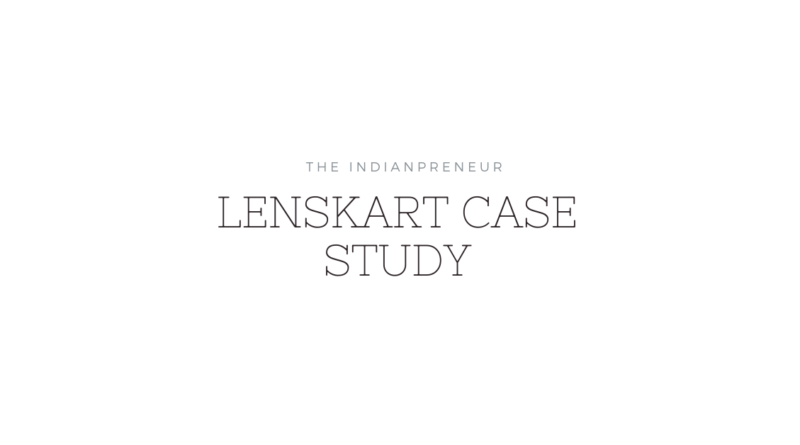
Lenskart Case Study: History, Valuation, Product, Services & Growth
Lenskart is an Indian eyewear online portal founded by Peyush Bansal in November 2010 in Delhi. Co-founders Amit Chaudhary and Sumeet Kapahi joined Peyush at a later date. The company’s portfolio of products ranges from prescription glasses, contact lenses to sunglasses.
HISTORY Peyush, is the founder & CEO of the company Valyoo Technologies, which is the parent company of LensKart. He pursued his Bachelor’s in Electrical Engineering — IT, Control & Automation from McGill University, Canada in 2006. Before he returned to India to pursue his PG in Management from IIM, Bangalore Peyush worked as a Program Manager with Microsoft for a year.
During his IIM days, he launched his company, Valyoo Technologies with SearchMyCampus as the first business portal in 2007. It was a classifieds site for students that went beyond accommodation to books, part-time jobs, carpool facilities, and internship opportunities. His motto was to solve any and every issue that a student might have.
SearchMyCampus was a big hit, but Peyush wanted to explore it in the e-commerce world. While exploring opportunities, he came across the eyewear segment which was even ignored by the big boys of e-commerce, viz., Amazon & eBay. He launched Flyrr.com — which was focussed on the eyewear market in the US. Flyrr was gaining good traction and this prompted him to test the waters in the Indian markets and launched Lenskart in November 2010. They started with just selling contact lenses and added eyeglasses a few months later. Finally, in March 2011 they added sunglasses to their portfolio and placed themselves in the fashion accessory segment.
VALUATION The company had a valuation of $1.5 billion by Dec 2019 after Softbank invested around $275 million. Peyush Bansal, a former Microsoft employee, founded Lenskart in 2010 along with Amit Chaudhary and Sumeet Kapahi.
Financial backers of Lenskart include TPG Growth, International Finance Corp, and Adveq Management. Ratan Tata (of Tata Sons) and S Gopalakrishnan (of Infosys) have also invested in Lenskart. In March 2018 Wipro Chairman Azim Premji invested 400cr in the group taking the valuation of the company to 3000 Crore. By 2016 Lenskart had become one of the two top optical chains in India, along with Titan Eye Plus. Its manufacturing facility in Delhi manufactures 300,000 glasses a month.
PRODUCT & SERVICES -Eyeglasses. -Premium Eyeglasses. -Sunglasses. -Shape. Wayfarer. Oval. Rounders. Cat Eye. Size. Small. -Brands. Bausch and Lomb. Johnson & Johnson. Alcon. -Color Contact Lenses, and many more.
GROWTH Lenskart becomes the last unicorn company in the year 2019. Lenskart is a New Delhi based startup founded in 2010. Lenskart app is with the widest collection of Specs, Sunglasses, Goggles, Frames, Anti Glare, Contact Lens, etc. Lenskart is India’s No.1 Online Shopping app for Specs, Sunglasses, Goggles, Frames, Anti Glare, Contact Lens, Reading Glasses, Computer Glasses, Try Glasses at Home, Prescription Sunglasses & Eye Accessories. Lenskart adopted an innovative approach to take customers in conversation with Lenskart via emails throughout the buying cycle. Unlike the traditional way of communication where customers were just informed about the status of their order, the company adopted the base of the full-duplex model where customers were able to share views, express their thoughts in the process and be virtually engaged. By giving importance to customer experiences and engaging in open communication, the brand becomes more human and builds trust.
Lenkart is providing 5000 styles of eyewear to choose from and gives free home delivery with 14 days replacement guarantee. From sunglasses to reading glasses to contact lenses, Lenskart makes everything in eyewear categories. Now with a chain of offline stores, Lenkart has acquired both online and offline markets of eye wears.
INTERNATIONAL OPERATIONS Financial backers of Lenskart include TPG Growth, International Finance Corp, and Adveq Management. Ratan Tata (of Tata Sons) and S Gopalakrishnan (of Infosys) have also invested in Lenskart. In March 2018 Wipro Chairman Azim Premji invested 400cr in the group taking the valuation of the company to 3000 Crore. By 2016 Lenskart had become one of the two top optical chains in India, along with Titan Eye Plus. Its manufacturing facility in Delhi manufactures 300,000 glasses a month. Lenskart also has a factory in Zhengzhou (China) which manufactures about 50% of the production. Lenskart launched the eyewear brand John Jacobs in 2017 and for that brand aimed to touch Rs 500 crore in revenue in two years. In 2018 the company became profitable (EBITD).
The company is in talks with the Japanese group SoftBank as well as the private equity firm Kedaara Capital for investment. These investments will make Lenskart next unicorn.
In October 2017, Lenskart’s first brand ambassador was Katrina Kaif. In March 2019 the company roped in Bhuvan Bam as their first male brand ambassador.
Click here to read more at The IndianPreneur.
- Swiggy Case Study: History, Valuation, Product, Services & Growth
- Nykaa Case Study: History, Valuation, Product, Services & Growth
Aparna Rawat
Aparna Rawat is a business content writer for The IndianPreneur.
Leave a Reply Cancel reply
Your email address will not be published. Required fields are marked *
Subscribe to our newsletter

💡[Case Study] Lenskart’s Strategy that Changed Indian Eyewear Industry Forever
[10 min read] learn how lenskart beat reliance and tata, one strategy at a time. here’s a deep dive that you just can’t miss readon👇🏼.
One word: Lenskart.
Vision of the company?
To bring ‘Vision to India'.
According to WHO, only one-third of the 100 million Indians who need a pair of spectacles have access to it.
Lenskart set out to change this.
And today, it has become a household name, with stores covering about 313 cities in the country.
The Indian eyewear market went from generating a revenue of $3.17 billion in 2014 to an estimated revenue of $6.10 billion in 2024. The market is set to grow at a 7.54% CAGR between 2024 and 2028.
While about 80% of this market is dominated by unorganised players, Lenskart captures around 41% share in the organized eyewear market.
It has even beaten giants like Tata's Titan and Reliance's Vision Express!
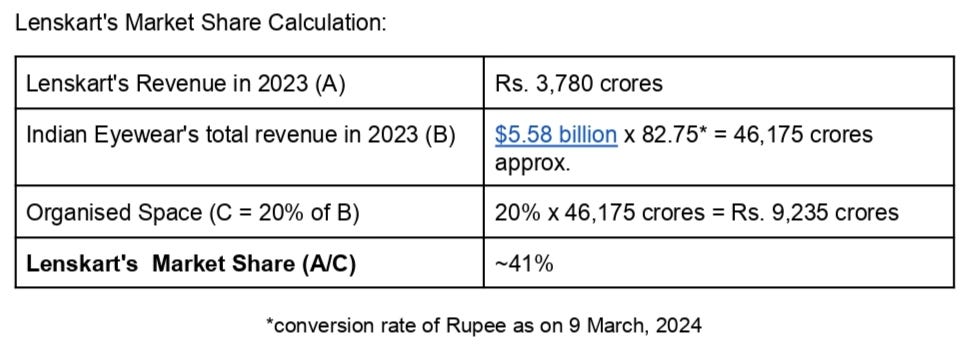
In this piece we will discuss:
Eyewear problems before Lenskart
The supply chain problem solved by Lenskart
The real hero of the eyewear industry revolution
What are other eyewear players doing?
Is the Lenskart model easy to replicate?
The future of eyewear industry
Lenskart Came, Saw & Conquered
Before the arrival of Lenskart in 2010, the Indian eyewear market was flooded with:
mediocre quality products,
limited design options, and
unorganised players offering no guarantees and no warranties.
Amongst all these deficiencies, three things were high in this market:
the lead time for deliveries,
the margin of error in the end products and
the cost of products to consumers.
Lenskart simply tried to solve these real customer problems:
Robotic automated eye-testing: Remember how it would take days to adjust into your new pair of glasses only to later realise that the power in the eyeglasses does not match the power in your eyes? Where traditional eyewear shops could not guarantee a 100% accuracy, Lenskart brought in best-in-class robotic technologies from Germany, offering zero error tolerance.
Virtual try-ons, easy returns: Remember when buying clothes without knowing how they would look on you seemed ridiculous? Then came the e-commerce boom that eased you into buying them online without any trial with features such as easy returns and exchanges.
But hey, specs are not socks. You would not buy a pair to match all your outfits. So when it came to buying eyewear, you had to be absolutely sure that they suit you.
To solve these user apprehensions without which online shopping of eyewear would be a dream, Lenskart came up with a brilliant use of augmented reality (AR) technologies to enable virtual 3D try-ons for its customers.
At-home and in-store eye checkups: A doctor’s visit was almost mandatory every time you needed to check your eye power. Lenskart realised the acute shortage of optometrists in the country and it started to offer at-home eye checkups by trained optometrists. Not shortly after, it became apparent that there were many people who could not even afford eye-check ups. Lenskart offered free in-store eye checkups, truly making vision correction much more accessible in India.
Good quality at affordable prices: One of the biggest problems in the Indian eyewear market was that eyewear prices were at extreme ends. Either you could opt for cheaper products with low quality or you had to spend a bomb for the good quality glasses. Only a very few could afford to opt for the high quality, high price products considering the need to often change eyeglasses due to a change in the power.
Lenskart identified a gap in the market where no one was selling good quality products in a mid-range segment that made customers say “paisa vasool!” It eliminated intermediaries in the supply chain and started to offer products at highly competitive prices.
Rapid delivery: Most e-commerce businesses had to compete with the instant gratification of offline purchases with a considerable time for delivery in online shopping. But where customers had to wait for 6-7 days to get delivery of glasses purchased at retail stores, Lenskart was offering a 72-hour delivery.
Hassle free returns: Most products that one would purchase online could be easily sold to other customers if returned. However, that does not hold true with spectacles which are customised for each user. But Lenskart was offering a 14-day no questions asked return policy, to help the users find ease in online eyewear shopping.
The Eyewear Industry Supply Chain
Like many other consumer products, eyeglasses were also predominantly imported from China. Following a traditional supply chain mechanism made eyeglasses an expensive affair.
How was the traditional supply chain structured?
Glasses were primarily imported from China by importers which then changed hands from distributors to retailers before reaching the end customer. At each leg of the supply chain, each intermediary kept a slice of the pie for themselves, increasing the cost of the product to the end customer.
What did Lenskart do when it entered the market?
They did what typically all e-commerce players were doing at that time. They became the sole middleman between the manufacturer and the customer, eliminating the importers, distributors and retailers of the supply chain. In doing so, they also eliminated the excess margins at each step of the chain.
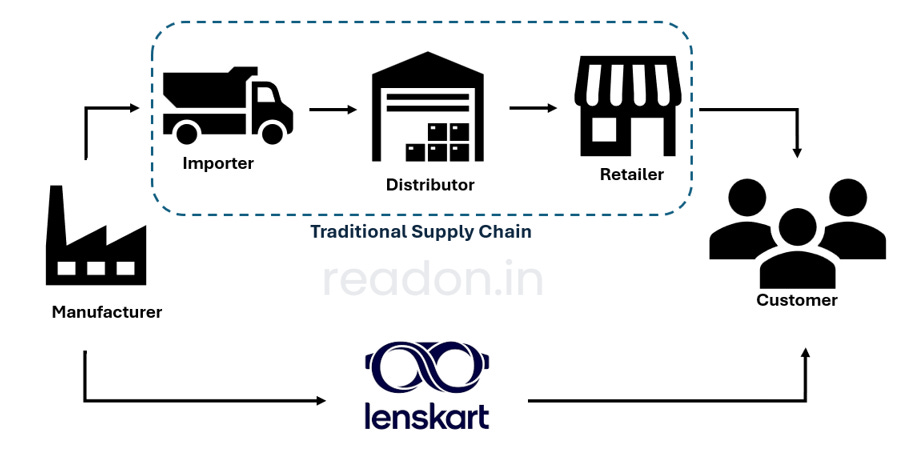
How did Lenskart gain competitive advantage with a lean supply chain?
Affordable pricing by eliminating intermediary costs.
Design and quality were much more in Lenskart’s control owing to its direct relation with manufacturers.
Reduced lead time as products were directly sourced from manufacturers.
Ease of business by eliminating middlemen helped Lenskart deal with hassles of collections, unsold inventories and write-offs that grappled the traditional supply chain.
The Real Hero of the Eyewear Industry Revolution: Tech
What technologies, you ask?
Let’s go through some of the most significant technological advancements in the eyewear industry.
Manufacturing: went from a laborious and heavy machinery reliant process to a computer-aided and automated process. As a result, higher quality products are produced with higher efficiency in lesser time.
Features: Lenskart, through its continuous research, development and innovation began offering lighter glasses with more features such as anti-glare glasses and blue light filtering lenses.
Automated testing: The accuracy of diagnosis in vision correction was not an easy problem to solve.By using zero error machinery and enabling at-home eye tests by trained optometrists, customers could now get their prescription without even stepping out of their homes.
Virtual try-ons: The use of cameras on smartphones and augmented reality (AR) helped solve the trial-before-purchase. Customers could simply upload a selfie and get recommendations based on size and style. They could even try on the glasses virtually from the comfort of their homes!
AI and machine learning: AI and ML provide personalised recommendations to customers to complement their facial features.
Other Players in the Eyewear Market
So, is Lenskart the “gunda” of the eyewear market?
Maybe, but it is not without a fight.
The lure and potential of India’s growing eyewear industry is lucrative and with about 80% of the market still unorganised, there is plenty of fish in the sea for everyone.
In fact, when Lenskart began its operations in 2010, it wasn't the only player.
There was already one player that was rapidly growing in the retail market. It had the backing of one of the most renowned and trusted brands in India – the Tatas.
Yes, we're talking about Titan Eyeplus, which was already 200 showrooms strong in 2011.
But today, Lenskart’s market share is 5 times that of all of Titan’s Eyewear brands like Titan Eyeplus and Fastrack put together.
When Tata is in the play, how can Ambani be far behind!
While Tatas were opening Titan Eyeplus stores across the country, Reliance entered into a joint venture with Europe’s Grand Vision opening a chain of Vision Express stores in the retail markets.
So how did Lenskart manage to surpass these companies with deep pockets and established brands in becoming a household name for eyewear?
Lenskart realised very early on in the game that while its D2C proposition is great, the eyewear industry cannot go completely online.
It adopted an omni-channel strategy.
Yes, while most D2C brands are now moving from an online-only to an omni-channel presence, Lenskart did this on day 1.
Not just legacy brands like Tata and Reliance, today the eyewear market has a number of new age D2C players like Specsmakers, Cool Winks, Eye My Eye and ClearDekho, walking on a path paved by Lenskart.
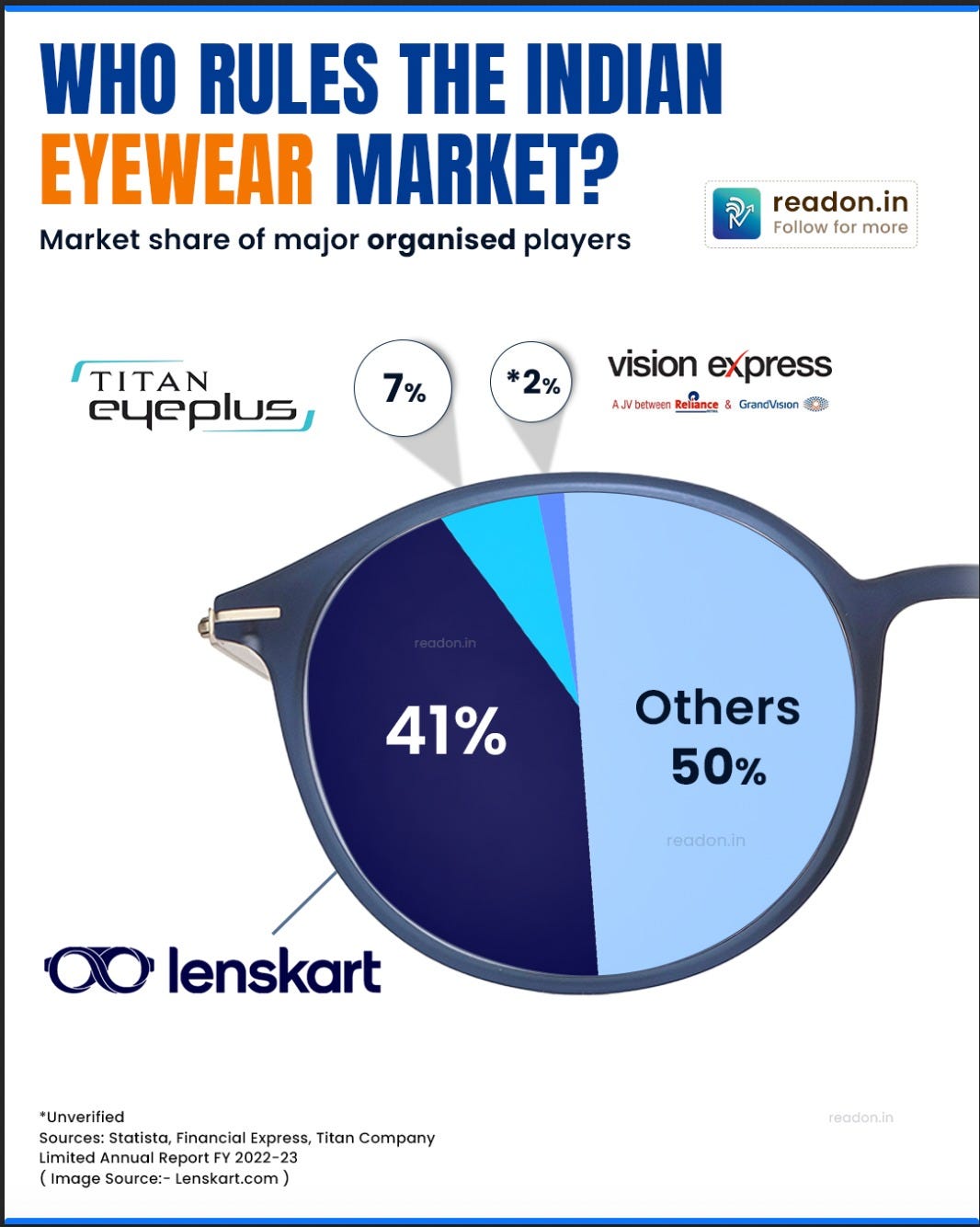
Lenskart, in FY23, was way ahead of its competition not only in terms of market share but also in terms of revenue. Where Lenskart reported a revenue of 3,780 crore rupees in FY23, Titan’s eyewear segment reported a revenue of 689 crore rupees .
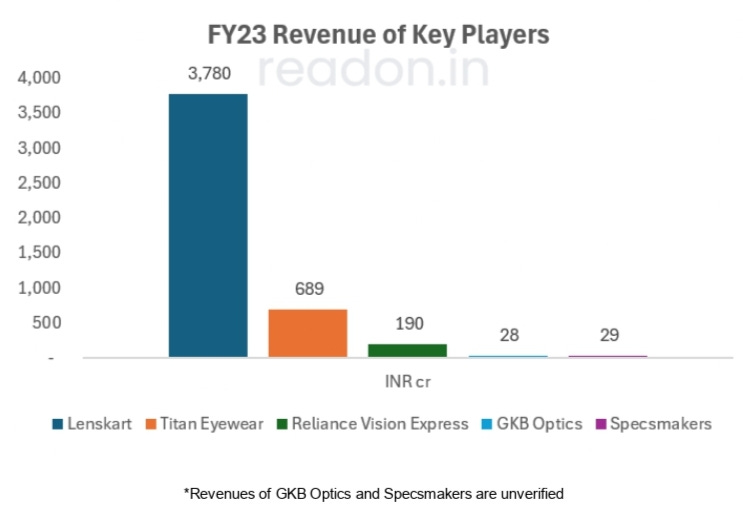
Not just in revenue, Lenskart has an upper hand even in its physical presence across the country, having over 1300 stores across 313 cities in India, 1.5 times the number of Titan Eyewear stores in India.
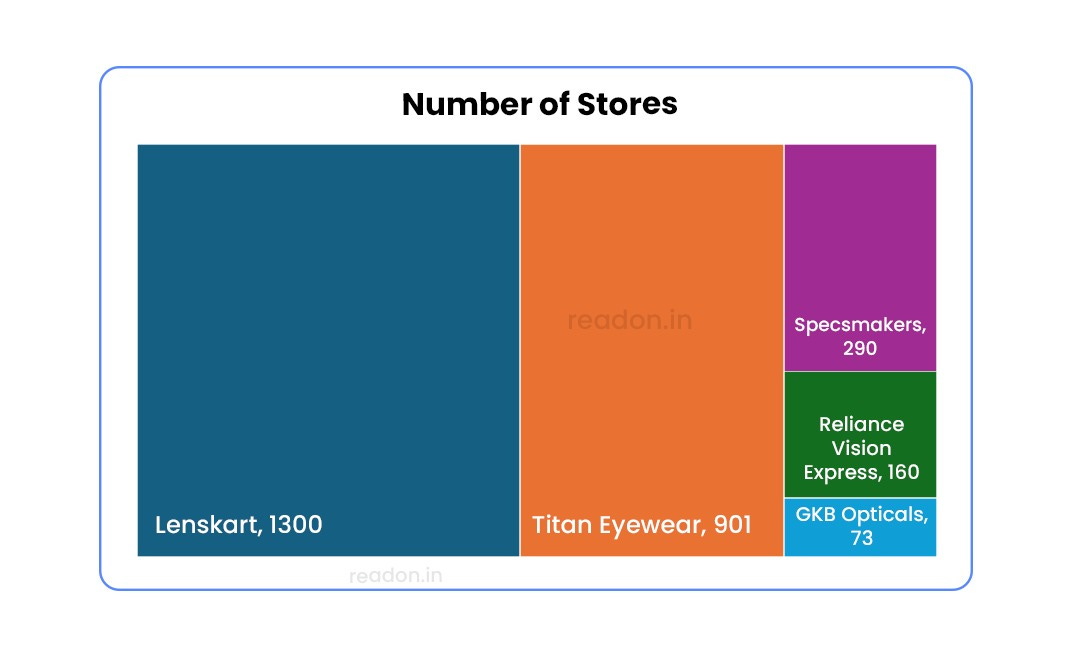
While Lenskart is clearly winning the volume game, it reported a profit of approximately 6.8% against its revenue in FY23 (amounting to Rs. 260 crore ) recovering from a Rs. 100 crore loss reported in FY22 .
Titan Eyewear, on the other hand, earned a profit at about 14.2% (amounting to 98 crore rupees ).
While information on profitability of other players is not publicly available, it would be interesting to see whether Lenskart can make money and still stay at the top.
Is Lenskart’s Model Easy to Replicate?
There is no denying that Lenskart did bring a brilliant vision into the India eyewear industry that forced even the biggies like Titan and Reliance to start offering online shopping experience to consumers.
The success of Lenskart did, undoubtedly, inspire many other D2C players into the market.
But this brings us to the question: while Lenskart is reaping the fruits of first mover advantage, has the Lenskart model now become easy to replicate?
The barrier of entry is easing with the increase in access to institutional capital and Lenskart has already done the back breaking work of getting the market accustomed to ease of online purchase of eyewear.
Today, all the major players in the market offer the same technological innovations and value propositions offered by Lenskart – be it virtual try-ons or affordable products or at-home eye testing.
Will Lenskart manage to retain or widen the gap between itself and its competitors or is it a matter of time before they catch up?
Well, even today, there are a few things that set Lenskart apart from its competition.
One of the biggest cards in Lenskart’s favor is its manufacturing setup . Over its time in the industry, Lenskart realised that to deliver true value to customers, it must have better control over production. Today, it operates the world’s largest automated eyewear manufacturing facility in India. Its vertical integration has enabled it to not just reduce its reliance on imports, but also to effectively manage turnaround times and inventory across the supply chain.
Second, Lenskart has exhibited great strength in its innovative solutions solving real consumer problems. One such example involves showcasing the true essence of its omni-channel presence by offering a pick-up-from-store service, wherein, the customers would select and order from the online store and pick up the ready product from the nearest store after trying it in person and being fully satisfied with the fit.
Future of Eyewear Industry
Like any other industry, the eyewear industry is bound to get more competitive and saturated with time, but the future of the industry’s favor will lie in continuous innovation.
Even today, there is a huge section of the market that remains unorganised and a consumer segment in Tier 2 and Tier 3 India is still untapped.
New and emerging companies, like ClearDekho are targeting these untapped markets and mining for exponential value.
While Lenskart is expanding its presence in the global market, Google and Apple are taking technological advancements and innovations to new heights by developing smart eyewear. With a combination of augmented reality, advanced computer vision and artificial intelligence, the end product could end up replacing our omnipresent smartphones.
As the market grows and evolves, the customer-centric approach and ability to innovate and demonstrate agility will determine the success of eyewear brands in the industry.
What would be key to note would be whether the businesses will grow with the support of hefty discounts and cash burns or whether sustainable, profitable businesses can emerge as competition increases.
Liked the piece? Share it!
Ready for more?

Peyush Bansal - How Did He Build Lenskart From Scratch?

Shalini Rath , Akash Kushwaha
When we think about fashion - items like clothes and footwear cross our minds. Fashion doesn't only stick to the clothes we wear, today specs are also a part of fashion and style statements. Spectacles have become a part of almost every individual.
In such times, when long working hours are unavoidable, and other stress levels cause many health problems, many people are deprived of vision correction. In India itself, about 550 million people need vision correction out of which only 170 million have them.
To provide better eyewear for every walk of age while keeping in view the quality and trend styles, Lenskart was founded. Peyush Bansal started the company in 2010 with a mission to deliver better eyewear and change the way people see through their eyes.
Peyush Bansal is regarded to be one of the most brilliant entrepreneurs in India. He started his journey from being a studious student to building a company at a global level. Peyush Bansal sparks inspiration for many of us.
Recently, he has gained a lot of popularity after becoming a judge on one of the most famous reality shows, Shark Tank India .
In this article, let's dig deep to learn more about Peyush Bansal's roller-coaster story of becoming an entrepreneur and how he started Lenskart from scratch.
Peyush Bansal - Biography
Peyush Bansal - Early Life Peyush Bansal - Career Peyush Bansal - Investments Peyush Bansal - Controversy Peyush Bansal - Awards & Achievements Peyush Bansal - Unknown Facts Peyush Bansal - Quotes
Peyush Bansal - Early Life
Born on 26th April 1986 in Delhi, Peyush Bansal lived with his parents and two siblings. His father's name is Bal Kishan Bansal, and his mother's name is Kiran Bansal. He has one elder brother and a younger sister.
Peyush Bansal did his schooling at Don Bosco School (Greater Kailash-II, New Delhi). After finishing high school, he prepared for IIT but didn't get through. So, he went to Canada to study electrical engineering at McGill University.
Just like any person with dreams and goals, Peyush Bansal always wanted to be a businessman. In India, he studied at the Indian Institute of Management, Bangalore, he holds a diploma in entrepreneurship.
Peyush has been lucky as his parents always supported him in his journey of becoming an entrepreneur . In 2011, he got married Nidhi Mittal and has a son.
Peyush Bansal - Career
After graduating in electrical engineering, Peyush Bansal bagged his first job at the tech giant- Microsoft , USA. He worked as a Program Manager for nearly one year but left the job in 2008 and came back to India.
Peyush was never interested in engineering, which is why he quit his job at Microsoft. After returning to India, he started to look for ideas to start his own company.
Despite not coming from a business background, Peyush came up with his first startup in 2007 called, SearchMycampus, while pursuing a degree in entrepreneurship from IIM, Bangalore.
SearchMycampus was an online portal to help students search for various issues related to jobs, housing, coaching, internships, transportation, books, etc. After the fair success of his first company, Peyush launched a couple of startups that ran quite well.
Along with his friends, Amit Chaudhary and Sumeet Kapahi he founded Lenskart in 2010. The idea came when Peyush came across the statistics of blind people in India, and only a small amount of people were wearing spectacles. Thus, he aimed to provide eyeglasses to a large number of people to improve their vision.

Peyush serves as the Chief Executive & People Officer at Lenskart. The company is headquartered in Faridabad, Delhi NCR. Initially, Lenskart dealt with selling only contact lenses but it slowly witnessed success and expanded its operation.
Today, Lenskart has over 1100 stores across different cities in India, offering more than 5000 eyewear styles. The online eyewear retailer entered the unicorn club in 2019.
Currently, the valuation of Lenskart is $4.5 billion.
Peyush Bansal - Investments
Peyush Bansal is a man of a wise and brilliant mind. He has made investments in various startups. Revamp Moto is his latest investment of their Pre-seed funding on June 1, 2022.
Some of the companies Peyush Bansal has invested in are:

Peyush Bansal - Controversy
In one of the episodes of the Indian reality show, 'Shark Tank India', Peyush Bansal was caught in a controversy. He passed down some comments related to CA, which later offended the CA community. The aftermath of comments led to the trend of #SayNoToLenskart on social media platforms, especially among CAs.
Following the events, Peyush Bansal took to social media where he shared a post asking for an apology.
Peyush Bansal - Awards & Achievements
Some of his achievements are as follows:
- Red Herring Top 100 Asia Award 2013
- Emerging Entrepreneur of the Year Award in 2012
- British Honor's Award at McGill University
- Best 40 under 40 entrepreneurs 2021 Fortune India
Peyush Bansal - Unknown Facts
- He loves watching suspense and thriller shows/web series.
- He loves to travel during his free time.
- He looks up to Bill Gates.
- His favorite sport is Cricket.
Peyush Bansal - Quotes
His popular quote, " I think Passion is the most important thing ."
“ As a budding entrepreneur, one should focus on value creation more than anything else .”
What is the net worth of Peyush Bansal?
The net worth of Peyush Bansal is approximately $75.5 million as of 2021.
What did Peyush Bansal study?
Peyush Bansal tried for IIT but could get into any college, he completed his Bachelor of Engineering from McGill University, Canada, and did the Management Programme for Entrepreneurs and Family Businesses (MPEFB) at IIM Bangalore.
How much stake does Peyush Bansal have in Lenskart?
Peyush Bansal has 8.21% stake in Lenskart
Must have tools for startups - Recommended by StartupTalky
- Convert Visitors into Leads- SeizeLead
- Payment Gateway- Razorpay
- Spy on your Competitors- Adspyder
- Manage your business smoothly- Google Workspace
Push Sports: How Is It Revolutionizing Sports Education and Safe Play Across India?
The Indian sports tech market is expected to grow from USD 1.2 billion in 2022 to USD 3.5 billion in 2027. In this industry, a company making a great name for itself is Push Sports. Push Sports is one of the fastest-growing sports-tech companies in India. The company
A Compassionate Approach: Launching a Successful Elderly Care Business
This article has been contributed by MP Deepu, Co-Founder & COO, SeniorWorld. In today's rapidly aging population, the need for innovative elderly care solutions has never been more pressing. As we strive to meet the diverse needs of seniors, it's crucial to approach the development of these services with empathy, compassion,
List of Top 17 Instant Loan Apps in India [2024]
At many points in our lives, we require loans to meet our needs. As per a CIC report published in June 2021, around half of India's working population has taken loans in some form. Among all types, a personal loan is quite convenient as it can be taken without any
Best AI Presentation Tools: Harnessing AI for Powerful Presentations
Crafting presentations that captivate and inspire is an art form that combines strategic planning, compelling content, and dynamic delivery. In today's fast-paced world, the ability to deliver powerful presentations is a skill sought after by professionals across all industries. Whether pitching a new idea, sharing insights, or rallying a team,

Elevating Eyewear: A Deep Dive into Lenskart’s Innovative Strategy
Table of Contents
Lenskart stands as a premier online eyewear emporium, boasting an extensive array of eyewear products within its virtual aisles. The store’s repertoire encompasses a diverse assemblage of eyewear brands, underpinned by a robust marketing framework. In this blog, we will delve into an exhaustive case study of the brand, dissecting its website, product spectrum, and intricate marketing strategy.
The entrance of Lenskart onto the Indian optical industry stage marked a seismic shift in conventional business paradigms. Traditionally, brick-and-mortar establishments reigned supreme in India’s optical sector. Procuring glasses, lenses, contact lenses, or sunglasses necessitated in-person visits to optical or retail outlets. Such establishments often extended eye check services, a strategy to magnetize new clientele. Concurrently, e-commerce burgeoned, yet it predominantly gravitated toward categories like household goods, edibles, attire, and electronics, leaving eyewear largely untouched.

About Lenskart
A visionary entrepreneur, the founder of Lenskart paved new avenues for consumer choice. This approach instilled trust in the brand’s credibility, facilitating online eyewear transactions. Similar to a pioneering sales technique, they primed consumers with novel concepts, subsequently inducing them to embrace online eyewear shopping.
The modus operandi spans both online and offline realms, positioning Lenskart as a preeminent force in India’s rapidly expanding business landscape. With a footprint gracing over 120 cities, 500 profitable stores, and a contented customer base exceeding 50 million, Lenskart is a flourishing network under the aegis of Valyoo Technologies, its parent company. Their app houses an extensive eyewear collection, reigning as the apex of online shopping apps, with offerings spanning computer glasses, reading glasses, contact lenses, anti-glare goggles, and spectacles.
The Architects Behind Lenskart
Peyush Bansal, born on April 26, 1985, and a graduate of Electrical Engineering from McGill University, Canada, laid the foundation. After securing a PGD in Entrepreneurship from the Indian Institute of Management, Bengaluru, he embarked on an entrepreneurial journey. Prior to Lenskart’s inception, he had birthed five other ventures, notably including Valyoo Technologies. This company, conceived during his IIM tenure, achieved remarkable success, amassing a staggering 2.5 million users. Recognizing the nascent eyewear market, he launched Flyrr.com in 2009, a US-focused online store retailing contact lenses and sunglasses. Transposing this model to India, Lenskart debuted in 2010.
Neha Bansal, a co-founder, transitioned from her role as a partner at Vinod Kumar and Associates. Collaborator Amit Choudhary, a Kolkata native and computer science engineer from BITs Mesra, brings a tech-savvy perspective. Additionally, Sumeet Kapahi, formerly associated with Luxottica India Eyewear Rayban, joined as a co-founder.
Lenskart’s SWOT Analysis
– Dominance in the market, with few formidable competitors – Ingenious utilization of advanced, patented technology – Solid foothold within the e-commerce realm – Robust brand portfolio and identity – Trend-setting store aesthetics – High-caliber, superior eyewear offerings
– Hesitation among Indian consumers regarding online eyewear purchases
Opportunities
– Expansion into international markets – Pioneering innovative concepts – Amplified focus on online sales
– Dynamic e-commerce landscape with increased competition – Regulatory shifts – Affordability challenges for specific demographic segments
Marketing Strategy: Lenskart’s Brilliance
1. inventory-centric business model.
Lenskart hinges on an inventory-based structure, furnishing a plethora of frame designs and superior lenses. The company liaises with suppliers to craft designs grounded in top-notch quality, durability, diversity, and innovation. Leveraging German robotic technology, Lenskart produces products with unparalleled precision.
2. Google Ads Dominance
Harnessing the digital era, Lenskart employs Google ads to amplify its visibility. Strategic keywords like frames, eyeglasses, and sunglasses bolster its reach, even extending to Google Shopping ads. Multiple formats, including videos and display ads, foster engagement.
3. Social Media Prowess
Facebook and Instagram serve as a playground for effective promotional campaigns. Classic marketing avenues, like TV and email, harmonize with the digital sphere to etch Lenskart as an eyewear authority.
4. Multi-Channel Excellence
Leveraging deep insights into Indian consumer psyche, Lenskart forged a hybrid approach, combining online and offline access. Over 550 brick-and-mortar locations across 30+ cities strengthen its market presence.
5. SEO Mastery
User-friendly optimization defines their website, amassing a substantial 1.8 million monthly visitors.
6. Quality Meets Affordability
The brand strategically targets the Indian market, offering innovative, reasonably priced products that embody excellence. “Lenskart Blu,” a shield against harmful UV rays, and the “Airflex” collection spotlight superior quality at accessible price points.
7. Celeb-Powered Appeal
Endorsed by prominent figures, Lenskart augments its products with style and celebrity flair. Brand ambassadors like Katrina Kaif and Bhuvan Bam draw in a youthful demographic.
8. Offline Franchise Impact
The brand’s offline expansion through franchises illuminated new avenues for growth. Pioneering over 720 stores nationwide, even during the pandemic, reaffirmed it’s commitment to customer convenience.
9. Immersive Virtual Reality
Their app offers an immersive 3D testing feature in partnership with Ditto, enabling users to virtually try out products. This has driven substantial daily traffic to the Lenskart website.
10. B2C Excellence
A direct-to-consumer model underscores the company’s operations, enabling cost-efficient access to its products. Collaborations with logistics partners ensure swift, secure deliveries.
11. Cutting-Edge Eye Testing
Lenskart’s advanced eye testing, utilizing imported equipment, enhances user experience. Experienced optometrists offer at-home testing, marrying convenience and innovation.
12. Tempting Discounts
Understanding the Indian affinity for discounts, IT leverages attractive deals, including complimentary eye exams and home-based frame trials. This strategic approach fortifies its user base.
In Conclusion
The hallmark of Lenskart’s ascent is its ingenious marketing strategies, positioning it as a leading light in the Indian startup landscape. The brand’s remarkable journey earned it a spot among the “Top 10 Promising E-commerce Indian Startups in 2021,” as per the Indian Wire. By providing an unparalleled array of eyewear solutions, Lenskart has truly captured the hearts of millions.
Also Read: Unveiling the Unstoppable Journey of Chai Sutta Bar: A Tale of Resilience and Triumph
Leave a comment cancel reply.
Your email address will not be published. Required fields are marked *
Save my name, email, and website in this browser for the next time I comment.

Lenskart Case Study : Marketing Strategy & Success Story
By Sreeresh | Date : 14-December-2022
Home > Blog > Lenskart case study

Lenskart is an online eyewear store and it provides a wide range of eyewear products.
It has a diverse collection of eyewear brands and it has a sound marketing strategy.
I will write a detailed lenskart case study based on their website, products and marketing strategy in detail in this blog.
The dramatic entry by Lenskart to the Indian optical industry landscape marked a paradigm shift in how the business was conducted.
The traditional model of doing business through brick-and-mortar stores was still the norm in India’s optical industry.
To purchase glasses, lenses, contact lenses or sunglasses, one must visit an optical shop or other retail shops .
Many optical shops offered eye checks for customers’ convenience, which helped to attract new customers.
While E-commerce was quickly gaining popularity and online shopping was rapidly catching up during this time, it mainly focused on household products and appliances, food and groceries, as well as clothing, footwear and jewelry.
It also offered electronic gadgets, such as smartphones and other digital devices. Online shopping was limited to sunglasses.
About Lenskart
The Lenskart founder was a genius in providing more purchasing options for consumers.
This helped establish Lenskart credibility and allow consumers to buy eyewear online.
This approach was similar to selling new concepts first, then inviting consumers to buy eyewear online.
Lenskart is an online and offline distribution channel. It is also one of the most popular ecommerce brands.
Customers can order Lenskart products through Lenskart’s imaginatively designed offline stores.
Lenskart is a fast-growing business network in India. It has more than 120 cities, over 500 stores that are profitable, and more than 50 million satisfied customers.
It is registered with Valyoo Technologies, its parent company. Lenskart app has the largest selection of eyewear, and is the most popular online shopping app.
It offers a wide range of eyewear including computer glasses and reading glasses.
The collection also includes contact lenses, anti-glare goggles and specs.
Founders Of Lenskart
Peyush Bansal: He was born 26 April 1985 and holds a Bachelor’s Degree in Electrical Engineering, IT Control & Automation, McGill University, Canada.
After completing his graduation in 2006 he completed his PGD in Entrepreneurship at IIM (Indian Institute of Management), Bengaluru.
He joined Microsoft in the USA as a program manager shortly after completing his PG.
After serving there for about 11 months, he returned to India to follow his dream of being an entrepreneur. Before Lenskart was launched, he had founded around five companies .
He founded Valyoo Technologies, his company during his IIM days. With Rs.
It was a huge success and attracted a staggering 25,00,000. It was an online classified portal that students could use to solve their problems.
You can find part-time work, carpool, internship opportunities , coaching books, and many other things.
He discovered that the eyewear market was very underdeveloped.
In June 2009, he launched Flyrr.com, an online shop. It sold contact lenses and sunglasses.
The store was primarily focused on the US market, but he decided that he could replicate the model in India and launch Lenskart in 2010.
Neha Bansal: She is also a co-founder at Lenskart. Before joining Lenskart, she was a partner in Vinod Kumar and Associates.
Amit Choudhary: Cofounder of Lenskart. Amit Chaudhary, a Computer Science Engineer at BITs Mesra in Ranchi, is also a co-founder.
He loves to travel and has a passion for it. He is a Kolkata native and attended Bharatiya Vidya Bhavan School.
He has made revolutionary changes to the business through his deep understanding of technology as well as his innovative ideas.
Sumeet Kapahi: a student at Delhi University, was previously a business development manager for Luxottica India Eyewear Rayban before joining Lenskart as one of its co-founders.
Lenskart Swot Analysis
- No big Competitor
- Advanced and patented technology usage
- Strong presence in the e-commerce business
- Strong brand portfolio
- Strong identify & brand image
- Trendy store layout
- High quality products
- Indian public is still not open to purchase eye-gear online
OPPORTUNITY
- Expansion in new markets: international markets
- Development of new concepts
- Increasing online sales
- Competitive or fluctuated e-commerce
- Change in government regulations
- Product prices may be too high for certain demographic groups to afford
Marketing Strategy Of Lenskart

1. Inventory Based
company system The business model is based on inventory. Lenskart provides thousands of frame designs and 45+ quality lenses for customers.
The company reveals the designs to its suppliers. In the process of developing items, Lenskart is focused on high-end design, durable, broad variety, ingenuity and even services like an in-depth 3D-based testing lab.
Lenskart utilizes German imported robotic technology that has resulted in Lenskart the sole Indian company to manufacture products with a precision that can reach 3-decimals.
2. Advertisement on Google (Google ads )
Google advertisements are among the most efficient strategies for companies in the present digital age.
Lenskart employs this strategy as well and also invests money in ads on Google. It makes use of popular keywords such as frames, eyeglasses, sunglasses as well as computer-related glasses.
It also advertises its products by using overpriced Google Shopping ads, where the user can also decide to take action.
Lenskart utilizes Google advertisements through video ads, display ads and app download advertisements as well as others.

3. Social Media campaign
They use Facebook and Instagram advertisements to promote their services.
Lenskart also makes use of traditional advertisements such as TV ads, newspaper advertisements, email marketing and many more.
These tin-based actions have allowed the brand to grow into a well-known and respected brand of eyewear in India
4. Multi-channel retailer Business Model
The company analyzed Indian mentality and observed that many people are wary of purchasing eyewear on the internet.
This is why it decided to establish bricks and mortar shops in India.
The company provides services that are available online as well as offline. It currently has 550+ locations spread across 30+ cities.
Lenskart Website is optimized for user-friendliness. The site has a solid seo and receives 1.8 million monthly visitors.
6. Concentrate on quality and cost Focus on quality and price
Lenskart was aware of the existing issues that existed in the Indian market. It was focused on launching new and affordable products that did not compromise on the quality.
“Lenskart Blu” is one of their most innovative products that shield the eyes against harmful ultraviolet radiation.
They also offer a wide selection of ultra-light, unbreakable and super-flexible glasses under the style”Airflex” “Airflex”.
7. Celebrity endorsements
Lenskart’s products do not provide a cure for eyesight. However, they also provide a style message for the customer.
So the brand promotes celebrities to appeal to the younger crowd.
First brand ambassador for Lenskart was Katrina Kaif followed by Bhuvan Bam.
Lenskart is associated with a variety of popular high-end brands such as Ray-Ban, Vogue, John Jacobs among others.
It allows customers to have access to a broad variety of high-end products in one place.
8. Franchises that operate offline
In the year 2014 Lenskart began to open offline shops to advertise its products.
The company took on the franchise model to cater to customers across India.
The company has now more than 720 stores across India and is planning to expand its reach.
The franchise business model has boosted the presence on the internet of Lenskart with the least expenditure.
In the event of the covid-19 pandemic the majority of businesses had to close their shops. and then go online.
However, Lenskart did something bold by opening up more than 300 stores to create an overall total of 1000 stores.
Lenskart is focused on bringing more customers via its stores that are not physically located.
9. Virtual reality technology
Lenskart gives a live experience to customers using its application.
The brand introduced its first-ever 3D test-on feature through a partnership with a start-up company in California called Ditto.
The feature allowed the user the opportunity to test any image in virtual real-time.
Peyush Bansal believed the feature an extremely successful marketing strategy. It brought more than 15,000 users each per day on the Lenskart website.
10. B2C model
B2C refers to Business-to-Customer. It is an e-commerce method which eliminates middlemen in order in the sale of products.
Lenskart utilizes this strategy to sell its goods through its websites as well as its mobile application.
This B2C model has allowed the company to create products that are affordable for everyone.
It gathers feedback from customers to better understand their behavior in marketing.
Lenskart has partnered with a variety of logistics firms, such as BlueDart, Delhivery, etc. for quick delivery services.
It assures prompt and secure delivery of their products to customers.
11.Modern eye testing
Lenskart offers the latest in technology eye testing for its customers in their stores and at their home.
The equipment used to test eyes is imported from the USA which is more efficient than traditional equipment and tools employed in India.
The customer must book an appointment for testing their eyes and an experienced optometrist will come to their home to complete the process of testing.
12. Discounts that are attractive
Lenskart has researched Indian attitudes and has realized that the local population is excited by discounts.
This is why the company has exciting discount deals and offers.
They also offer special discounts, such as free eye exams, giving the first frame at no cost to new customers and many more.
The test at home facility is a unique offer by itself. The specialist in eyewear carries with him the most popular frames available for customers to test in their own homes.
Discounts and offers have proven to be among the most effective strategies for marketing and have brought many customers to the site.
Lenskart is recognized among the most prestigious startups in India because of its distinctive marketing strategies.
It was also included in the ” Top 10 promising e-commerce Indian startups in 2021″ by the Indian Wire.
The company has won millions of hearts through providing the most effective eyewear options to the masses.
No thanks, I’m not interested!

Lenskart Business Model Case Study – How Does Lenskart Work?
Supti Nandi
Updated on: August 10, 2023
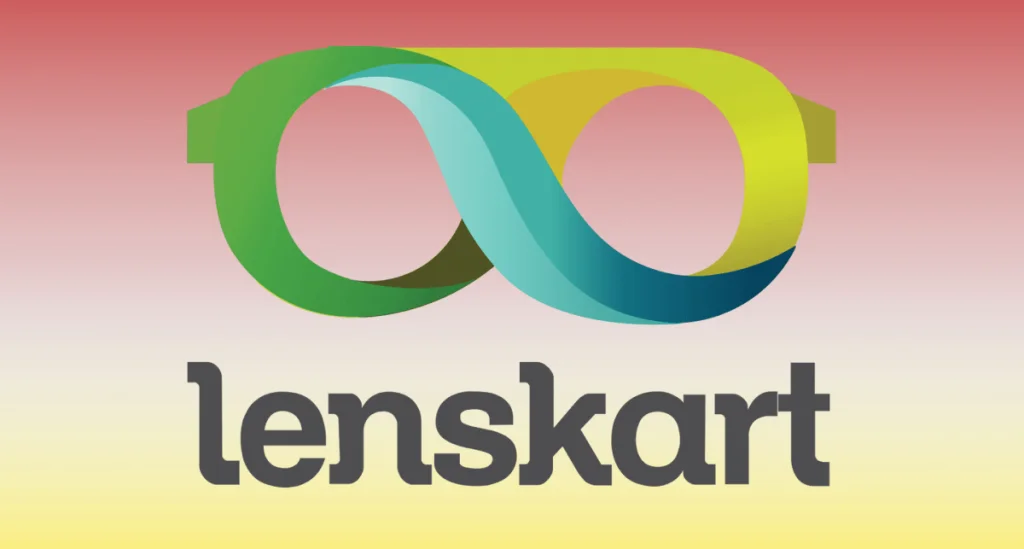
Lenskart is one of the leading brands that is ruling the market of eyewear accessories. But its journey was not that easy! Why? You may wonder. Because it was launched during the time when online shopping was accessible to only a handful of Indians. Also, people lacked trust in online products and services.
Fortunately, the scenario changed and the evolution of the Internet gave new rays of hope to online brands like Lenskart. It became one of the greatest eyewear brands in India. But how? Through its business model. So, here we are presenting the “Lenskart Business Model” with its numerous revenue sources & marketing strategies.
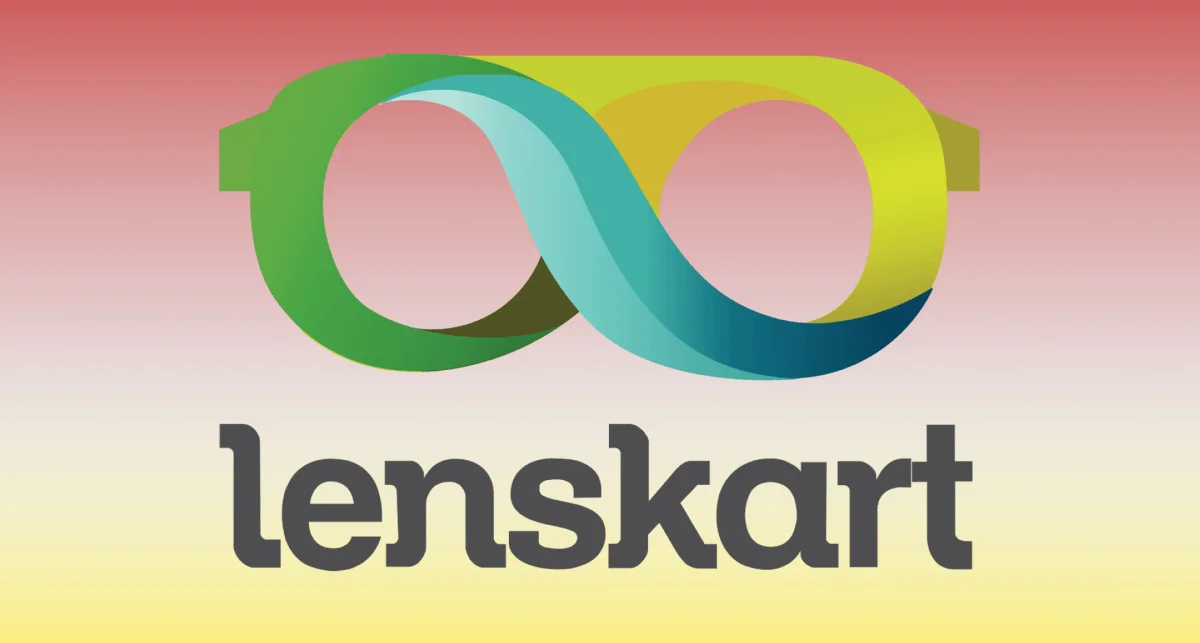
Stay tuned!
Lenskart: A Brief Overview
Lenskart is an Indian e-commerce company that specializes in eyewear, including eyeglasses, sunglasses, and contact lenses. It is one of the D2C brands that went offline too to expand its services. It has a unique business model that aims to provide eyewear of high quality at affordable prices. Before jumping into the details of the Lenskart Business Model, let’s have a brief overview of the company-
Working Strategy: How Does Lenskart Work?
Lenskart business model is based on eliminating the middlemen to sell high-quality eyewear to millions of Indians at affordable prices. Lenskart’s working strategy revolves around providing a seamless and convenient shopping experience to its customers. This D2C brand accomplishes its tasks through a combination of online and offline channels. Below are some key elements of Lenskart’s working strategy-
1. Inventory-based Model

Lenskart’s business model starts with designing and manufacturing most of the products themselves. This means it is based on an inventory-based model. Eventually, it helps them maintain quality control. And reduce the price of the products compared to what they would have been if they were outsourcing the manufacturing processes. Its manufacturing facility is located in New Delhi. As per the reports, it manufactures more than 3 lakh glasses per month. Lenskart provides the following types of products-
- Contact lenses
- Eyeglasses
- Reading Glasses
- Computer Glasses
- Kids Glasses
- Polarized Glasses
- Other vision care products
2. “Home try-on” Feature
This model allows you (customers) to select up to five frames and have them delivered to your home for a trial period at no cost. The execute delivers the trial frames and waits till you try the frames and select the perfect one. The “Home try-on” feature is the key highlight of Lenskart Business model. The customers can try the frames and decide which one suits them best before making a purchase, which gives them greater control and confidence in their purchase decision.
3. Franchise Model (Omni channel Presence)
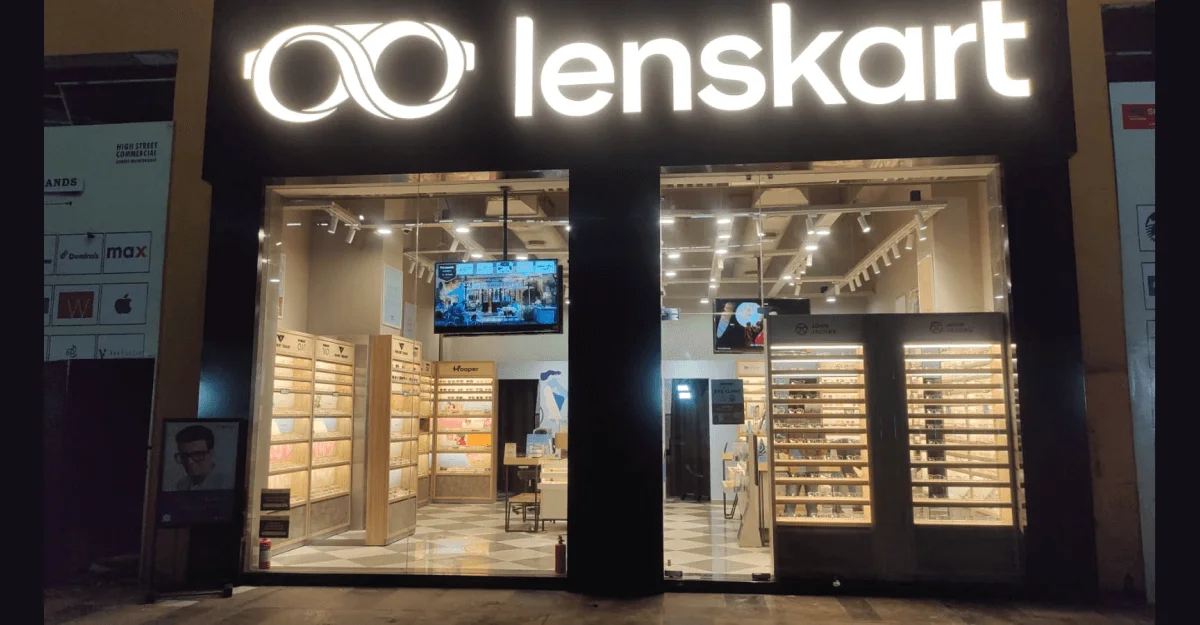
In addition to its online presence, Lenskart also has a network of physical stores across India. These stores are based on the franchise model . Here, customers can try on eyewear and get their eyes tested by qualified optometrists. The company has grown rapidly since its establishment. Thus, Lenskart has both an online and offline presence. This omnichannel presence allows Lenskart to reach customers who prefer to shop online or offline. This feature provides a seamless shopping experience across channels. As of April 2023, Lenskart has over 2,000 stores in India.
To own a Lenskart franchise, you need to invest Rs.35-40 lakh. In the Lenskart franchise, you can expect a profit margin of 13-35% with more than 30% ROI (Return on Investment).
4. Strong Supply Chain & Logistics
Lenskart has a strong supply chain and logistics network. The broad network allows it to deliver eyewear products quickly and efficiently. The company has its own manufacturing unit and works closely with its suppliers to ensure timely delivery of products.
Do you know Lenskart is famous for its “Try Before You Buy” model? Because you get free trials before buying it. Being a customer, you need to follow the given steps to find the perfect lens of your choice.
Step 1: Choose the frames
First of all, you need to select the frames of your choice and need. You can select a maximum of five frames. Then add them into the cart for “Home trial.”
Step 2: Payment
You need to pay a verification charge of Rs.1 for this service. You can go for digital payment options like Paytm , PhonePe , UPI, etc.
Step 3: Home Trial
Lenskart’s delivery executive delivers those frames to your doorstep. You can try them and check whether they are the perfect fit for you or not. The delivery executive waits till you make a final choice.
Step 4: Confirmation
Once you finalize the model, fill up the form and place that order online.
Step 5: Final Delivery of the product
Finally, post-confirmation, Lenskart delivers the package (selected frame) in the next 2-3 days.
6. Investment in technology
Lenskart uses technology to enhance its customer experience and optimize its operations. The company has developed a mobile app that allows customers to virtually try on eyewear using their phone’s camera and has also introduced AI-powered chatbots to assist customers with their queries. Also, it has a strong focus on innovation. It is constantly introducing new products and services to enhance its customer experience. The company has introduced products like Blue cut lenses, 3D printed eyewear, Smart glasses, etc. It also has a subscription feature called “Lenskart Gold Membership.” We will discuss it in detail in the section “Revenue Sources.”
Revenue Sources: How does Lenskart Earn money?
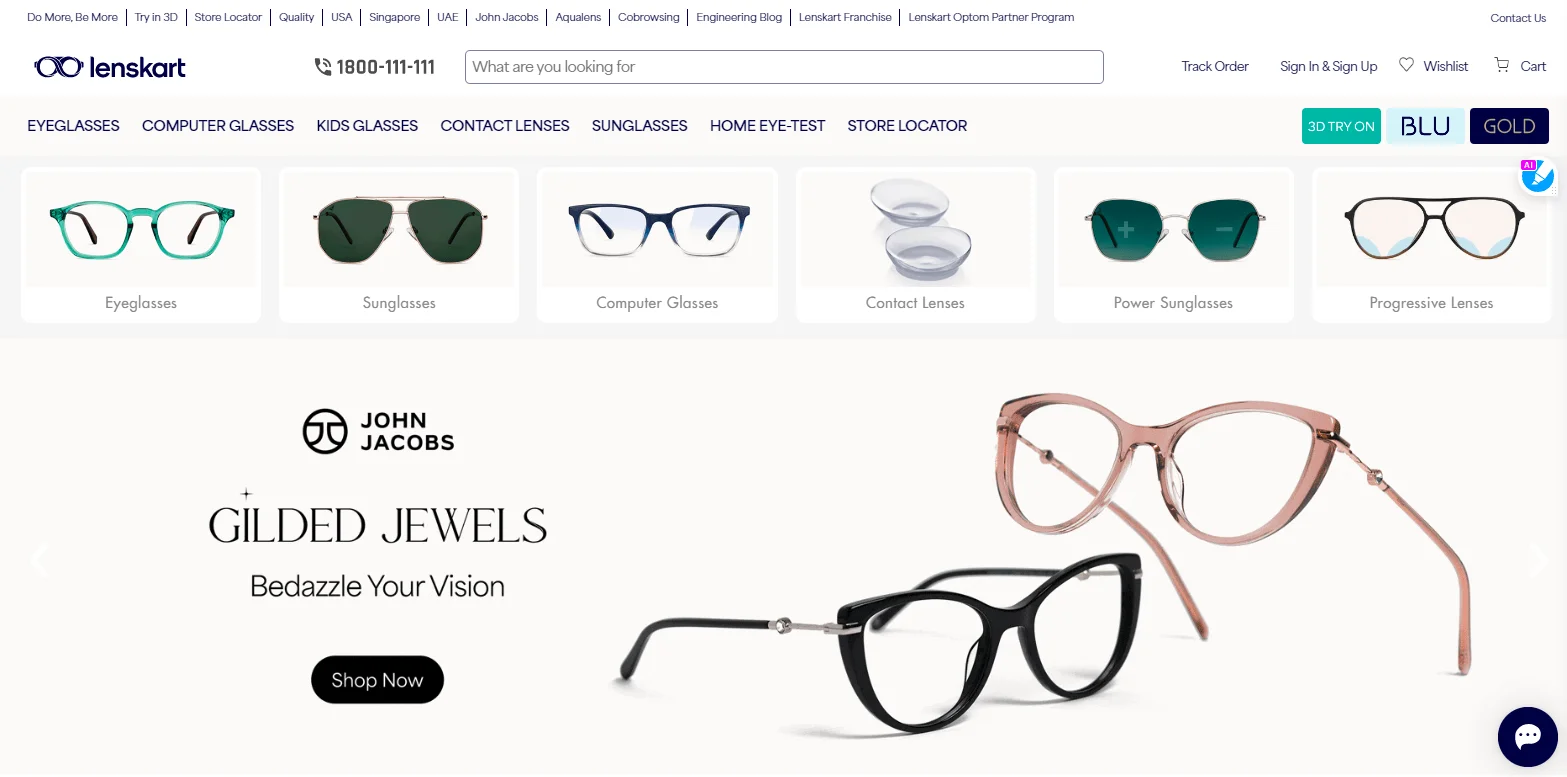
In the fiscal year 2022, Lenskart earned revenue of Rs.1,503 crores through its diverse revenue sources. Some of the major revenue sources of Lenskart are-
1. Sale of Products
The sale of eyewear products was the main source of income for Lenskart in FY22. It contributed around 94.3% of the total operating revenue. The company makes money with different price points of eyewear to cater to the diverse needs of its customers. The remaining revenue came from subscription fees and other sources.
2. Subscription Feature
Lenskart has a famous subscription feature “Lenskart Gold Membership.” It is a loyalty plan with which you can get exclusive offers for a whole year. These offers also include the privilege of “Buy 1 Get 1,” free eye checkups, etc. The total membership cost for one year is Rs.708 including the GST. This acts as a crucial source of revenue apart from the sale of products.
3. Home-eye Checkups

Lenskart provides free home eye checkups to its customers, which can lead to increased sales of eyewear products. Additionally, the company charges a fee for eye checkups for customers who are not looking to purchase eyewear products. These checkups cost a minimum of Rs.99. Thus, it provides an additional revenue stream.
4. Physical Stores
Lenskart also earns revenue from its physical stores across India, where customers can try on eyewear and get their eyes tested by qualified optometrists. The company charges a fee for eye checkups at its physical stores.
Thus, with numerous revenue sources, Lenskart has successfully gained a strong foothold in the market of eyewear.
Marketing Strategies
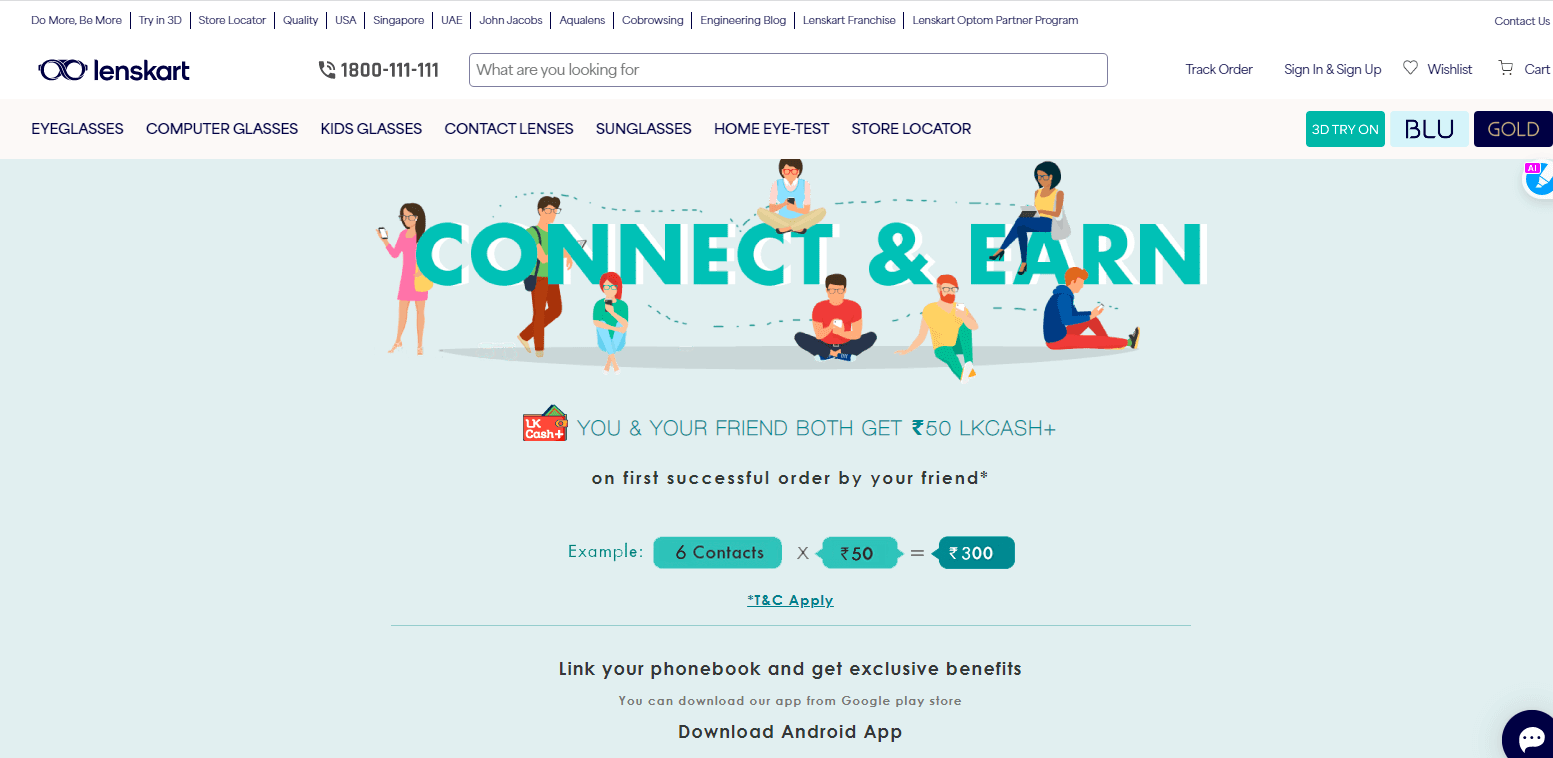
Lenskart uses various marketing strategies to reach and engage with its target audience. Some of the major ones are-
1. Television Advertisements
Lenskart heavily relies on interesting and entertaining television advertisements. The TV ads not only gain the attention of the viewers but also encourages them to try Lenskart glasses. Television commercials have played a crucial role in bringing awareness regarding the brand in the market.
2. Celebrity endorsements
Lenskart has roped in several celebrities, including Katrina Kaif, Bhuvan Bam, and others, to endorse its products and services. These endorsements help to increase brand visibility and credibility and attract new customers.
3. Partnerships and collaborations
Lenskart has partnered with several brands and organizations to reach a wider audience and provide additional value to its customers. Some of the key partners of Lenskart are-
- Lowe Lintas
- Owndays (Japanese eyewear brand)
4. Referral program
Lenskart has a referral program that incentivizes existing customers to refer their friends and family to the platform. Its popular referral program is “Connect & Earn.” Here you will get Rs.50 if your referred contact makes a purchase on Lenskart. However, terms and conditions apply to these offers. This program helps to increase customer acquisition and loyalty and provides an additional revenue stream for the company.
Challenges Faced by Lenskart
Lenskart faces the following competition in the market-
1. Offline Competition
Traditional brick-and-mortar eyewear stores pose competition, requiring Lenskart to find ways to attract customers away from the convenience of physical stores.
2. Quality Perception
Overcoming the perception that online eyewear might compromise on quality compared to in-person purchases was a significant hurdle. The inability to physically try on glasses online led to concerns about fit and style, which Lenskart had to address with virtual try-on technology.
3. Customer Education
Educating customers about the importance of regular eye check-ups, correct prescriptions, and understanding different lens options was essential.
4. Returns & Refunds
Managing returns and refunds for eyewear with prescription lenses can be complex due to customization, requiring clear policies and procedures.
5. Market Saturation
As the online eyewear market grew, Lenskart faced increased competition from new entrants, making differentiation and customer retention more challenging.
6. Competitive Pricing & Fashion Trends
Balancing competitive pricing and offering discounts without affecting profitability was a constant challenge. Staying up-to-date with changing fashion trends and offering a variety of styles that appeal to a diverse customer base required continuous effort.
Lenskart has tackled these challenges through a combination of innovative technology, customer-centric strategies, and effective communication to maintain its position as a leading player in the online eyewear industry.
The company’s focus on customer satisfaction and convenience has helped it establish a strong presence in the Indian eyewear market. With increasing demands, Lenskart is looking for building an automated factory in Bhiwadi (Rajasthan). It will have to capacity to produce 5 crore glasses per month. Thus, Lenskart Business Model has played a main role to achieve the heights of success!
Related Posts:
I bought lenskart goggles, very comfortable
Glad to know that!
Contact Info: Axponent Media Pvt Ltd, 706-707 , 7th Floor Tower A , Iris Tech Park, Sector 48, Sohna Road, Gurugram, India, Pin - 122018
© The Business Rule 2024

Sunjjoy Chaudhri
(Business Case Study Expert)
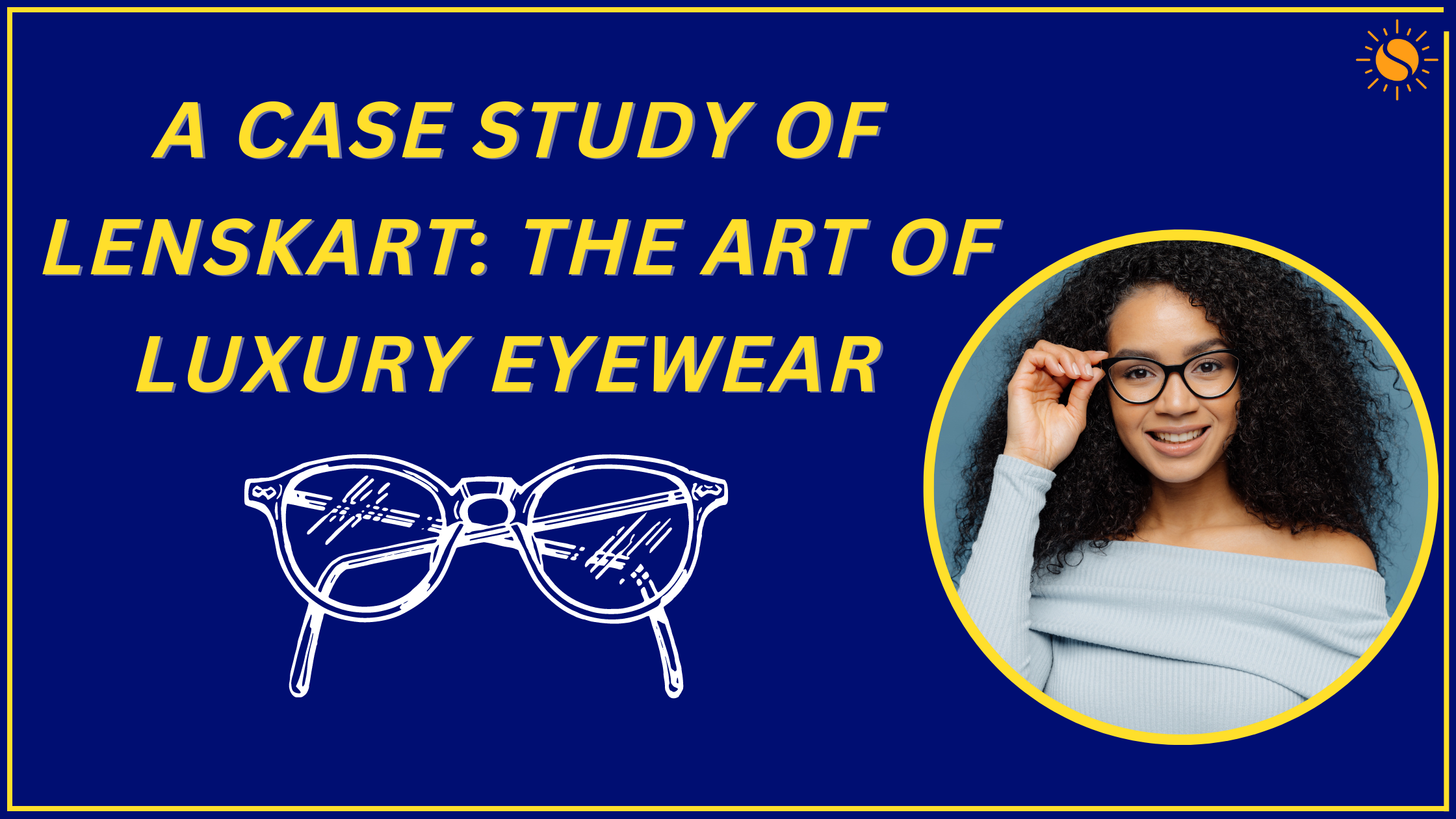
A Lenskart case study: The Art of Luxury Eyewear
Introduction about lenskart case study.
Lenskart is an Indian company that sells various types of eyewear, including glasses, sunglasses, contact lenses, and eye care accessories. They started in 2010 and now have over 700 retail stores all over India.
To stay on top in the eyewear industry, Lenskart uses smart marketing strategies to reach their target customers and make their products known. They advertise through social media, search engines, influencers, and traditional methods like offline advertising. This helps Lenskart build its brand, stand out from competitors, and increase sales.
This blog will explore Lenskart Case study, how Lenskart marketing strategy has contributed to its success. We’ll look at the different ways they promote their products, assess the effectiveness of their campaigns, and highlight the importance of marketing in achieving their business goals. Moreover, we’ll provide useful information and recommendations for other businesses aiming to create effective marketing plans for their own products or services.
About lenskart Conpamy
Lenskart, founded in 2010 by Peyush Bansal, Amit Chaudhary, and Sumeet Kapahi, is an Indian eyewear company. Initially an online platform, it has expanded to include over 700 retail stores across more than 175 cities in India.
Lenskart offers a wide range of eyewear products such as prescription glasses, sunglasses, contact lenses, and eye care accessories. They have their own brands like John Jacobs, Vincent Chase, and Mask, in addition to selling products from other popular brands.
Their website provides helpful tools like virtual try-on, home eye check-ups, and a 3D try-on experience. With virtual try-on, customers can see how glasses look on their face without physically trying them on. Lenskart also offers personalized lenses, free home delivery, and a 14-day return policy.
Lenskart has a significant presence in the Indian market and is one of the leading eyewear brands in the country. They have successfully captured a substantial share of the online eyewear market and expanded their reach through offline retail stores.
Through their innovative ideas, diverse eyewear options, and strong online and offline presence, Lenskart has become a prominent player in the Indian eyewear industry. They always introduce new and imaginative eyewear styles to meet customer demands and have established a solid position in the market.
Lenskart marketing Strategy
Marketing is crucial for businesses as it helps them grow by increasing brand awareness, attracting new customers, and boosting product sales. Lenskart, a successful eyewear company, has adopted a multi-channel marketing approach to reach its target audience. They use various digital marketing channels like social media, search engines, and influencers, along with offline advertising like billboards, TV commercials, and print ads.
Lenskart marketing Strategy focuses on providing a seamless customer experience through their online platform. They offer convenient features like virtual try-on, home eye check-ups, and a 3D try-on experience. They also provide services such as free home delivery, a 14-day return policy, and dedicated customer support.
To stand out from competitors, Lenskart employs strategies like celebrity endorsements loke katrina kaif, strategic partnerships, and innovative marketing campaigns. Their private label brands like John Jacobs, Vincent Chase, and Mask contribute to their unique brand identity.
In summary, Lenskart’s marketing strategies have played a significant role in their growth and success. Their multi-channel approach, emphasis on customer experience, and innovative campaigns have helped them establish a dominant position in the Indian eyewear industry.
Lenskart Business Model
Lenskart offers a wide range of eyewear options, including over 5000 frames and glasses, and more than 45 types of lenses. They have a team of designers who stay updated with the latest trends and work closely with manufacturers to create new designs.
To make their products accessible to more people, Lenskart has opened offline stores through franchise partnerships. They currently have 500 stores across 66 cities, including smaller towns. They serve thousands of customers every day and plan to increase their reach in the future.
There are four key factors that contribute to Lenskartsuccess in this industry: product quality, variety, timely delivery, and good customer service. They offer high-quality products at affordable prices. With a team of over 1000 employees, they handle manufacturing, eye technicians, customer service, technology, and logistics to meet the growing demands.
Lenskart Franchise
Lenskart, one of India’s largest online eyewear retailers, offers franchise opportunities for entrepreneurs looking to start their own businesses. Here are some details on the franchise cost and requirements, the benefits of owning a Lenskart franchise, and marketing strategies for franchise owners.
The initial investment required to start a Lenskart franchise ranges from INR 30-50 lakhs (approximately USD 40,000-68,000), depending on the location and size of the store. The franchisee must have a minimum floor space of 400-500 sq. ft. and a good location with high footfall. Other requirements include a security deposit, store interiors, inventory, and staff salaries.
Benefits of Owning a Lenskart Franchise:
Owning a Lenskart franchise offers several benefits, including:
- Established Brand: Lenskart is a well-known brand in India and has a strong market presence, making it easier for franchisees to attract customers.
- Support and Training: Lenskart provides extensive training to its franchisees on product knowledge, customer service, and marketing strategies.
- Marketing Support: Lenskart provides marketing support to its franchisees, including national advertising campaigns, social media marketing, and local promotions.
- High Margins: The eyewear industry has high margins, and Lenskart offers competitive pricing, allowing franchisees to earn higher profits.
Lenskart Marketing Strategies for Franchise Owners:
Here are some marketing strategies that Lenskart franchise owners can use to promote their stores and attract customers:
- Local Promotion: Host events, such as eye check-up camps, eye health awareness drives, and free eye tests, to attract customers to the store.
- Social Media Marketing: Use social media platforms like Facebook and Instagram to promote the store, offer discounts, and showcase new collections.
- Referral Programs: Offer incentives to customers who refer friends and family to the store, such as discounts on future purchases.
- Loyalty Programs: Offer a loyalty program to incentivize repeat purchases and build customer loyalty.
In conclusion, owning a Lenskart franchise can be a lucrative opportunity for entrepreneurs interested in the eyewear industry. With an established brand, extensive training, and marketing support, franchisees can successfully promote their store and attract customers using local promotions, social media marketing, referral programs, and loyalty programs.
lenskart’s Valuation and Future Prospects
Lenskart is one of the leading online eyewear retailers in India, founded in 2010 by Peyush Bansal, Amit Chaudhary, and Sumeet Kapahi. Here are some details on Lenskart’s current valuation, future prospects, and role in the Indian eyewear industry.
Current Valuation:
Lenskart has seen significant growth in recent years and has become one of the most valuable startups in India. In December 2020, Lenskart raised $276 million in a funding round led by SoftBank Vision Fund 2, valuing the company at $1.5 billion.
Future Prospects:
With the increasing adoption of e-commerce and the growing demand for eyewear in India, Lenskart is well-positioned for future growth. The company plans to expand its product offerings, open more physical stores, and further develop its technology capabilities to improve the customer experience.
Lenskart’s Role in the Indian Eyewear Industry:
Lenskart has played a significant role in transforming the Indian eyewear industry by offering high-quality eyewear at affordable prices and making it more accessible through its online platform and physical stores. The company has also introduced innovative technologies such as the 3D Try-On feature, which allows customers to virtually try on frames before making a purchase.
Lenskart has also launched its own range of private-label eyewear, including frames, sunglasses, and contact lenses, offering customers more options at competitive prices. In addition to its online platform, Lenskart has a rapidly expanding network of physical stores, with over 700 stores in more than 175 cities in India, making it one of the largest optical retail chains in the country.
In conclusion, Lenskart’s current valuation and future prospects show that it is a leading player in the Indian eyewear industry. With its innovative technology, affordable pricing, and expanding physical presence, Lenskart is well-positioned for continued growth and success.
Recap of Key Takeaways from the Blog:
In this blog, we explored various aspects of Lenskart, one of the leading online eyewear retailers in India. We discussed Lenskart’s history, products and services, marketing strategies, franchise opportunities, and future prospects. Here are some key takeaways from the blog:
- Lenskart was founded in 2010 and has become one of the most valuable startups in India.
- The company offers a wide range of eyewear products and services, including frames, sunglasses, contact lenses, and reading glasses.
- Lenskart’s marketing strategies include digital marketing, social media marketing, and innovative advertising campaigns.
- Owning a Lenskart franchise can be a lucrative opportunity, and franchise owners can benefit from the company’s marketing support.
- Lenskart’s current valuation is $1.5 billion, and the company is well-positioned for future growth.
Final Thoughts on Lenskart Marketing Strategies and Future Prospects:
Lenskart has established itself as a leading player in the Indian eyewear industry through its innovative marketing strategies, high-quality products, and expanding physical presence. The company’s marketing approach, which includes a focus on digital marketing and social media, has helped it reach a wide audience and build a loyal customer base. Lenskart’s private label eyewear and 3D Try-On feature have also set it apart from competitors and helped it build a strong brand identity.
With its current valuation of $1.5 billion and plans for further expansion, Lenskart is well-positioned for future growth and success. As the Indian eyewear market continues to grow, Lenskart’s innovative marketing strategies and customer-centric approach will likely continue to be a key drivers of its success. For More Such Case Studies Visit sunjjoychaudhri.com

Sunjjoy Chaudhri Has Been an Entrepreneur Since the Age Of 23, Sunjjoy Chaudhri is a Founder of Setup Mastery, Fxpopsan Exchangers and Malgangas Consultancy. Sunjjoy Chaudhri is a Highly Accomplished and renowned business consultant based in Pune. With an Impressive track Record and a Wealth of Experience, Sunjjoy has Established himself as one of the best Business Consultants in the Region
2 thoughts on “A Lenskart case study: The Art of Luxury Eyewear”
- Pingback: Redbus The Comfortable Way To Travel: Case Study - SUNJJOY CHAUDHRI
- Pingback: Unleashing Success: Harnessing The Power Of Competitor Analysis Tools
Leave a Comment Cancel reply
Save my name, email, and website in this browser for the next time I comment.

- Pre-Recorded Courses
- Free SEO Tools

Case Study- Digital Marketing Strategies of Lenskart 2024
- March 22, 2024

Table of Contents
A few decades ago, spectacles or glasses were not fashionable at all. But now, in 2024, glasses have turned into fashion accessories.
Spectacles have evolved into a symbol of knowledge and style along with facilitating us to see the world around us a little better.
One such business, which has revolutionized the eyewear industry, is Lenskart.
Lenskart was founded in the year 2010 by Peyush Bansal along with Sumeet Kapahi and Amit Chaudhary and was initially called “Valyoo Technologies” .

It was started to help almost 1/3 rd of the Indian population suffering from eyesight issues by making quality eyewear and lenses affordable.
Affordable luxury would be a better articulation of their mission and vision statement. They eliminated the cost of middlemen by utilizing in-house robotic technology to manufacture their lenses and eyewear components.
Lenskart has over 5000 varieties of frames which is the largest collection among any retailer in India. Their top brands include RayBan, Oakley, and some amazing in-house collections.
They provide at-home try-on for their frames, home eye-test, and trial of lenses, have innumerable offline stores and flagship stores, and an amazing membership policy as well.
Lenskart has evolved tremendously in its inventory and reach from serving 30 customers a day to 3000 customers. Their revenue has increased to almost $2.5 billion with a monthly customer visit rate of 1 lakh.
And a part of this success needs to be credited to an innovative and engaging marketing strategy implemented by Lenskart. But before we analyze their digital marketing strategy, let us understand the importance of learning about the latest trends in marketing and how we can benefit from them.
Why Should Marketers Study Digital Marketing Strategies?
Digital Marketing is a fast-growing field and the need for well-informed and knowledgeable marketers has increased.
Learning about the latest marketing case studies , and strategies of brands will provide you with an edge over your competitors. And this edge is extremely beneficial in the long run.
It will help establish your brand and will make way for future career opportunities in the field of digital marketing.
It provides valuable insight into consumer behaviour, helps analyze and interpret real-time data efficiently, and helps in developing your critical thinking and problem-solving skills .
Possessing updated knowledge will help the implementation of holistic and innovative strategies.
These strategies facilitate the success of your marketing plan yielding favourable outcomes for both the business client and yourself. Better insights into the current trends open doors to amazing career opportunities which provide attractive salaries and benefits.
With enough experience, diversified careers in marketing can be explored due to the flexibility that comes with staying updated.
It also helps in the conceptualization and establishment of your marketing agency. As the industry will never face a recession, your job will continue to be stable and better opportunities will come along.
These are just some of the many benefits that one can experience by constantly researching and learning about the latest digital marketing practices.
Let us now discuss Lenskart’s ideal target segment around which three of its successful marketing campaigns were created.
Lenskart’s Target Segment
Lenskart’s top engagement audience comes in the age groups of 18-24 and 25-34.
About 38.74% of the audience belongs to the 18-24 age group making it their largest consumer pool.
And 35.96% of their audience belongs to the age group of 25-34. This implies that millennials and GenZ are their ideal clientele.

12.01% of Lenskart’s consumer base is made of those in the age group of 35-44. These are the top 3 contributors to engagement.
When it comes to gender-based distinctions, 62.30% of their consumers are male, while the remaining 37.70% are females.
Lenskart’s Digital Marketing Campaigns & Strategies
Let us now look at the digital marketing campaigns conceptualized and promoted by Lenskart that proved to be successful in their growth and revenue.
Campaign 1 – The War of Fair Prices #KaranVSPeyush
“The War of Fair Prices” was a digital campaign by Lenskart featuring Karan Johar and Peyush Bansal. The campaign aimed to create awareness about the fair pricing of eyewear and how it can change consumers’ perceptions of the high cost of eyeglasses.
The campaign effectively leveraged the celebrity endorsement of Karan Johar and the credibility of Peyush Bansal, the CEO of Lenskart, to drive home the message.
The use of humor and relatable scenarios made the campaign appealing to the target audience and helped in building brand recall.
The campaign received widesprea d attention on social media , contributing to the overall brand awareness and perception of Lenskart as a trusted and affordable eyewear retailer.
Campaign 2 – Nazar Ghati Durghatna Ghati 2.0
Launched during the IPL season in October of 2021 , this was Lenskart’s hilarious take on solving issues that might originate due to poor vision. The ad campaign consisted of a series of short ad films which hilariously dealt with the topic of mishaps due to poor sight.
The ads utilized some of the top unbelievable and hilarious IPL moments to market the importance of good sights. From fielders colliding with each other and the wicketkeeper being unable to take the wicket, they all ended on a humorous note with the saying “Nazar ghati, dhurgatna ghati” .
The ad campaign also focused a film on a player using a protection cup instead of a face mask and cleverly marketed the need for their quality lenses and glasses.
The main purpose of this ad was to showcase their latest Augmented reality feature which now allowed customers to try on their virtual glasses and even receive suggestions depending on their face shape, all in under 10 seconds.
The ads were exclusively run during the IPL season on social media platforms like YouTube, Instagram, Facebook, and Twitter. They were also broadcast on television.
The ad was a roaring success as 1 out of 4 customers were trying the new feature, and conversions were pouring in.
One of the main reasons for the huge success of this campaign, apart from the wit and humour, was the timing. They created consumer-centric ads by taking advantage of the excitement around IPL and expanding their demographic.
Campaign 3 – #HalkaRakhYaar
The #Halkarakhyaar campaign was launched in October 2019. This was the first set of TVC ads that were conceptualized and created by Mullen Lowe Lintas group, with Bhuvan Bam as Lenskart’s brand ambassador .
This campaign aimed to showcase their AIR range which harmoniously blends style, comfort, and functionality. They opted for a carefree and free-spirited approach to showcase the modern and eclectic style of their latest collection.
A series of ad films were shot with Bhuvan as a pivotal character for plots that were fun, engaging, and relatable.
They implied their standard tone of wit and humour when dealing with common scenarios and created very memorable content for their audience. This was a consumer-centric campaign in the sense that the whole idea was based on valuable insight received from consumers about a need for light, airy, and stylish eyewear.
This was a revolutionary campaign as they broke the traditional stereotypes associated with celebrity endorsements by roping in Bhuvan Bam, a well-known YouTube star, as their brand ambassador.
This ad was marketed on television and social media platforms like YouTube, Instagram, and Facebook to reach a much wider demographic. The ad reflected their quirky and unique brand identity, helped tap into the influencer marketing potential, and successfully increased their online presence and sales.
Campaign 4 – Pride 22 #SeeTheLove
Launched in June of 2022, the main aim of the campaign was to spark conversations about fluidity, freedom to express, curiosity, boldness, and carefreeness that extend beyond the month of June. The real conversations that matter.
By building on the line “See the love, not labels. See the pride, not prejudice” , Lenskart released its collection of bold, colourful, inclusive, freeing, and proud eyewear to symbolize its support for the LGBTQ+ community as a proud ally. The eyewear experimented with iconic PRIDE symbols, colours, and objects to symbolize the concept of being free and unapologetically yourself.
The series of ad films told stories that mattered and consisted of proud members of the LGBTQ+ to narrating those stories.
Lenskart released a series of 7 episodes under this campaign to narrate the stories of how the community continues to enrich our lives and how the members like to identify themselves.
These ad campaigns were marketed on social media platforms and on Lenskart’s official website to reach a wider demographic. Overall, the campaign proved to be a success due to its authenticity, quality, and its perfect timing.
Lenskart’s Social Media Marketing Strategies & Case Study
2.76% of Lenskart’s engagement comes from different social media platforms like YouTube, Facebook, and Instagram. That means that almost 2.8k visitors a month are solely pouring in through ads marketed on these social media platforms.
Social media marketing refers to promoting a business online on specific platforms based on the requirements of that business.
It is one of the most effective marketing strategies due to its cost-effectiveness, potential to convert leads, and high flexibility.

Social media marketing is a budget-friendly way to create an updated and engaging online and social presence that reflects your brand identity and value.
Lenskart has a well-rounded and engaging social media presence on YouTube, Facebook, Instagram, LinkedIn, and Whatsapp.
Let’s briefly look at their YouTube , Facebook, Linkedin, Twitter, and Instagram, marketing channels & followers;
YouTube is one of their largest channels, with 166k subscribers and a cumulative view count of more than 3.5 million. It is responsible for 53.42% of the total traffic, making it the largest contributor. They mostly curate updates on the latest collection, offers, and unboxing videos for their YouTube channel. They also repost influencer content to increase their presence.

Facebook and LinkedIn occupy the 2 nd and 3 rd positions respectively by contributing 19.79% and 08.83% each. With close to 174k followers on LinkedIn, Lenskart is one of the few businesses that are appropriately utilizing LinkedIn to reach a highly specific demographic.
And their Facebook account has 1.5 million followers who engage with their content regularly. Their Facebook content consists of updates on the latest offers and deals, service-related information, and an aesthetic feed to reflect their brand image.
WhatsApp occupies the 4 th position by bringing in 7.91% of the traffic respectively.
Lenskart’s SEO Strategies & Case Study
Optimizing your online presence is the best approach to improving your online visibility, ranking and reach. And the process of doing that is SEO.
Search Engine Optimization refers to the process of optimizing a website to improve its ranking on search engines and increase visibility and online presence.
It helps generate organic traffic and is great for adding credibility and transparency to any business.
SEO also helps with quality lead generation and conversions . It is a great cost-effective strategy to improve the growth of your business.

35.21% of Lenskart’s traffic is generated by organic searches. This indicates a highly optimized online presence. The business receives 5.6 million visits a month for an average duration of 4.2 minutes each.
They occupy the 16 th position in the country concerning online shopping and the marketplace. Having said this, Lenskart’s bounce rate is rather high, with 45.6% of its visitors leaving the site after surfing through only 1 page.
Lenskart has updated its website to ensure it always ranks first when its name is searched, regardless of any new updates that happen in the search engine. It is a mobile-first, SEO-friendly website .
They have highly specific CTA buttons, which are great for converting leads into conversions and retargeting.
They have an optimized SMS and email bundle, which is sent out regularly which helps consumers complete their purchases and again helps with retargeting.
Over 61% of its traffic is organic, and Lensakrt has optimized its keyword database with over 3000 keywords to help with its ranking.
The top 5 searches that drive traffic to the Lenskart website are
- Lenskart.com
- Lenskart India
- Lenskart near me are
Other keywords include
- Specs, and similar words in the group.

Lenskart has an engaging and highly interactive content marketing strategy and social media strategy which promotes its brand and hence makes it memorable.
Overall, they have optimized their presence to help with better lead generation and conversions, but there is an area for improvement in their bounce rate and retargeting tactics.
Lenskart’s Website Strategy

Lenskart’s official website has been optimized by embedding 54 technologies to ensure a smooth customer experience. These technologies have been taken from 13 different industries like advertising, currency converters and payment systems, conversions and analytics, mobile , and so much more.
The website has been optimized for search engines. It has a mobile-first approach and facilitates easy navigation through clear and simple categories.
They also display their vast visual inventory in an organized format along with their international stores. Eyeglasses, computer glasses, kids’ glasses, lenses, sunglasses, hope tests and trials, and store locators are the major categories. Each of these has been further classified for easy access and ordering. They also provide a user-friendly order tracking system to update customers on their purchases.
The visuals are engaging and have a lot of movement in them which is great for grabbing and maintaining the attention of the consumers. The filters are highly versatile and flexible, which contributes to a hassle-free and enjoyable customer experience. Lenskart also emphasizes flexibility in payments which is great for confirming successful purchases.
Overall, Lenskart has a well-rounded and highly optimized website which is great for improving its online visibility, generating leads, and increasing revenue.
Lenskart’s Paid Ad Strategies & Case Study
Paid ads refer to the concept of generating ad campaigns through a service provider and paying them an agreed-upon amount when their ads generate leads. It works on a commission basis.
Paid ads are great for directing quality leads and traffic to the website of any business. They are more flexible in terms of budget and concept in comparison to traditional marketing practices. They are profitable as they have high ROI. Paid ads are measurable and bring about almost immediate results.
Almost 40% of Lenskart’s traffic is generated by paid ads. 5 important paid ad strategies have been optimized to improve its reach and sales. They are PPC, social media ads, influencer marketing, banner ads, and Ad retargeting.
Pay-per-click ads are placed at high-engagement areas online and on partner sites to generate high-quality leads that end in conversions. They have placed social media ads on their official account and in high-traffic areas to attract the right audience. Most of Lenskart’s ad campaigns are promoted on social media and through direct marketing and hence have a wide reach.
Lenskart has broken influencer marketing stereotypes by roping in a popular YouTuber as its official brand ambassador. This was an extremely smart move that enabled them to tap into a highly specific and already engaged audience. And they have a well-rounded retargeting strategy that involves constant reminders through email and SMS which helps in following through with the leads.
Lenskart’s Influencer Marketing Strategy
Influencer marketing is one of the most profitable and trendy marketing practices. It refers to the idea of influencers or those with an online following promoting businesses to their followers.
It works based on the trust and loyalty that these opinion leaders have earned, which puts them alongside experts.
It is far more budget-friendly than celebrity endorsements without compromising on the reach or quality of leads. It reduces marketing efforts as influencers come up with creative ways to market the product, which reduces the burden of ad conceptualization on the parent company.
And lastly, it generates high-quality leads with a high chance of conversion because the audience is already engaged with the product through the influencer.
Lenskart has a fully optimized influencer marketing strategy which is reflected in its choice in going for a YouTuber as its brand ambassador.
1% of their traffic comes through direct referrals and 2.76% from social media. This makes the influencer marketing strategy a highly beneficial one.
They collaborate with lifestyle, tech, fashion, wellness, and other similar category influencers to generate content for their promotions and social media pages.
They focus on the quality of content but there are still areas like the authenticity and uniqueness of their content, which can still be improved.
Lenskart’s E-commerce Strategy & Case Study
Any strategy that is implemented to help boost the sales of your online business is called an e-commerce strategy . The main aim is to increase the online presence of your business by promoting your brand.
Lenskart has a fully optimized e-commerce strategy which has helped the business grow tremendously over the years.
In the year 2014, Lenskart decided to go online with its business. They implemented the D2C approach or the direct-to-customer approach.

This eliminated all the middlemen involved and the commission they cut and therefore reduced the price of quality eyewear.
This is one of the most important e-commerce strategies which has helped Lenskart establish its brand value and presence in the Indian e-commerce market.
To ensure smooth and efficient delivery, Lenskart has tied up with logistics companies like Bluedart and Delhivery . This has ensured a great experience for their customers.
They also have a fully optimized website and mobile app that helps improve the customer experience and also contributes toward recurring sales.
They have a clearly defined clientele group which facilitates the optimization of all their marketing channels. This widens their reach and impact, thus contributing to better sales.
They have also successfully marketed their content to reach a large audience and this has contributed to inculcating loyalty towards the brand.
Overall, Lenskart has an extremely dynamic and holistic e-commerce strategy which is one of the key contributors to revenue.
Lenskart’s App Strategy
In 2022, mobile applications are a must for any large business. They create a 24/7 presence for the brand, reflect the identity of the brand, and help with brand value. It is also a great way to provide your customers with a smooth and hassle-free experience. And this makes your business memorable and a cut above the rest.

Lenskart’s mobile app is extremely well-developed and fit to be navigated by all age groups. With a simple and clear UI design, visual inventory display, customer support access, and distinctive categories, the whole process of surfing and ordering eyewear has been simplified. The latest collections, offers, updates, and deals are displayed in big bold banners at the beginning to attract new leads.
One of the most unique features of their app is the 3-D virtual try-on . This provides the customers with an opportunity to make quick decisions and buy products much faster.
The login and registration processes are extremely clear and simple.
The app also has the provision to book home eye tests and also locate the nearest stores.
The application has several panels like the admin panel, consumer panel, eye test panel, and delivery panel.
This facilitates effective communication between the teams and ensures smooth order processing.
Lenskart’s Content Marketing Strategy
From getting Katrina Kaif on board as Lenskart’s brand ambassador to creating stellar ads, Lenskart always had a strong content marketing strategy.
Content marketing refers to the concept of sharing valuable content in the form of videos, blogs, podcasts, ads, or social media posts to help keep customers engaged, attract new leads, and maintain their loyalty.
It is a cost-effective way to make a memorable presence and promote brand awareness. It also deeply reflects your brand value.
Businesses that utilize content to stay connected generate 67% more leads and more than 47% of consumers go through the content of a business before making a purchase.
And 72% of businesses will agree that content marketing is an extremely powerful tool for generating quality leads.
Lenskart utilizes its content pool very efficiently to market to its ideal clientele.
They have quirky and innovative ads, blogs, unboxing videos, influencer material, and social media posts.
Lenskart’s official blog creates articles related to people and culture, fashion, lifestyle, technology and product development, and startups.
Their social media pages are updated, dynamic, and highly engaging with posts on the latest market trends.
They have even mobilized meme marketing to ensure that they connect with a younger demographic and create a great impression. This indicates their omnipresent approach to promoting their business through content.
Lenskart’s Organic Competitors
Lenskart operates both online and offline. While this hybrid model has several benefits, it also presents a plethora of competitors, from both domains.
Apart from other retailers in the area, Lenskart’s top five organic competitors are
- Titan eye plus
- Essilor India

Flipkart has the highest affinity score of 100% and hence occupies 1 st place on the list.
Titan eye plus and Eye my eye have affinity scores of 92% and 85% respectively.
Essilor India and Tatacliq occupy the 4 th and 5 th positions with affinity scores of 84% and 79%.
These are the top 5 competitors and the diagram represents other important factors like monthly view rate and category rank to provide a better understanding of the competitors.
Lenskart’s aim of making quality eyewear affordable by eliminating middlemen and using in-house robot technology is a strength.
Their team consists of trained professionals who conduct eye tests and write prescriptions. This adds credibility to their business.
Lenskart’s willingness to educate the customers on their best options is a great tactic to build trust and loyalty.
And finally, their versatile collection of brands, designs, and categories of eyewear ensures there is something for everyone.
With strengths come weaknesses and achieving the right balance with pricing is key to establishing brand identity and value.
You can neither price it too low nor too high. Low prices might tarnish brand value while high prices might lose customers to other retailers.
Now coming to ways through which they can optimize their reach, Lenskart has several ways to tap into wider demographics using the latest tools and resources to increase the consumer base.
Adding customization features to their frames is a great tactic to generate quality leads and sales . And improving their social media presence by enhancing creativity and innovation in their content is great to improve their presence while attracting new customers and retaining loyal ones.
Lenskart also has a series of challenges that hinder its progress. Stiff competition from online and offline retailers dilutes the quality of leads and traffic that comes their way. And a constant need to stay innovative and unique can get taxing.
But overall, Lenskart has implemented several innovative marketing strategies to help reach its goals faster.
Within a span of a decade, they have evolved into a top business force in the country. Through its consumer-centric approach to product development and marketing, Lenskart will continue to thrive and grow.
Enrol in Digital Scholar’s online digital marketing course to improve your company’s digital marketing tactics. This course is for anyone interested in learning everything there is to know about digital marketing and how to apply it to their own company.
What do you love the most about Lenskart? Let us know in the comments below!
Also, check the list of digital marketing case studies of brands:
MRF Tyres Digital Marketing Case Study
Flipkart’s Digital Marketing Strategies
Mama Earth’s Digital Marketing Strategies
Tanishq’s Digital marketing strategies
First Cry’s Digital Marketing Strategies
Shopclues’s Digital Marketing Strategies
Amazon’s Digital Marketing Strategies
Cadbury’s Digital Marketing Strategies
Written By Digital Scholar
Digital Scholar is a premier agency-styled digital marketing institute in India. Which offers an online digital marketing course and a free digital marketing course worldwide to elevate their digital skills and become industry experts. Digital Scholar is headed by Sorav Jain and co-founder Rishi Jain, who are pioneers in the field of digital marketing. Digital Scholar’s blogs touch upon numerous aspects of digital marketing and help you get intensive ideas of different domains of digital marketing.
Leave a Reply Cancel reply
Your email address will not be published. Required fields are marked *
Save my name, email, and website in this browser for the next time I comment.
Recent Posts

10 Best SEO Competitor Analysis Tools To Improve Your Traffic in 2024 [Free & Paid]

What is LinkedIn Pulse? A Complete Guide

Top 10 Pros and Cons of Digital Marketing in 2024

20 Best Income Opportunities in The World To Try in 2023
Slider jquery of your page of your page 1 2 3 slider jquery by WOWSlider.com v8.8
By department.
- Research Publications 52381
- Researchers 5498
- Organization Units 167
- Projects 121
This repository provides metadata of IIMB Publications and aimed at creating and preserving an archive of Institution scholarship. IIMB Publications include Articles, Working Papers (FULL TEXT), Book Chapters published by Faculty, Doctoral Dissertations by FPM Scholars and Project reports of Students enrolled in various courses of IIMB.
- Students Scholar Bank
Files in This Item:
Google Scholar TM
Items in DSpace are protected by copyright, with all rights reserved, unless otherwise indicated.
Fill up the form and submit
On the order page of our write essay service website, you will be given a form that includes requirements. You will have to fill it up and submit.
Professional Essay Writer at Your Disposal!
Quality over quantity is a motto we at Essay Service support. We might not have as many paper writers as any other legitimate essay writer service, but our team is the cream-of-the-crop. On top of that, we hire writers based on their degrees, allowing us to expand the overall field speciality depth! Having this variation allows clients to buy essay and order any assignment that they could need from our fast paper writing service; just be sure to select the best person for your job!


IMAGES
VIDEO
COMMENTS
Lenskart Business Case Study. Jun 15, 2021 • Download as PPSX, PDF •. 2 likes • 7,260 views. I. Ishita Mishra. Includes the complete journey of Lenskart along with its current status in the market and business model canvas. Business. 1 of 15. Download now.
AI-enhanced title and description. V. Vijay Mirgule. Lenskart is an online eyewear retailer founded in 2010 in India. It offers over 10,000 styles of glasses and sunglasses from brands like Rayban and Oakley. Lenskart uses innovative features like virtual try-on and at-home eye exams. It has expanded to over 100 stores across India and delivers ...
Lenskart case study. B2C model- B2C refers to Business-to-Customer. It is an e-commerce strategy that eliminates the middlemen to sell the products. Lenskart uses this technique to sell its products through its websites and its mobile app. The B2C model has helped the brand make its products affordable for all.
NSBC Case Study Challenge- Lenskart Rachel Kujur IIM-A Priyanshi Barman LIBA Jeremy Kujur MRU INDUSTRY OVERVIEW MARKET INSIGHTS • Eyewear market is projected ...
A Case Study on Lenskart By Josie Patra September 15, 2021 Image Source- Flickr Article Overview Introduction: The change begins About Lenskart Company and its unique approach Removing the barriers to business Gaining the trust of consumers Expanding the reach A Sales oriented business model Enhanced convenience for customers Evidence of customer trust History Growth and Features: The business ...
The company had a valuation of $1.5 billion by Dec 2019 after Softbank invested around $275 million. Peyush Bansal, a former Microsoft employee, founded Lenskart in 2010 along with Amit Chaudhary and Sumeet Kapahi. Financial backers of Lenskart include TPG Growth, International Finance Corp, and Adveq Management.
The 9 building blocks used in lenskart. Education. 1 of 10. Download now. Presentation On Lenskart.com | Building Blocks of Lenskart.com - Download as a PDF or view online for free.
What is Lenskart? Lenskart is an e-commercecompany India's leading online shopping portal foreyewear Products range from a large selection of eyeglasses, sunglasses and contact lenses Founded by Peyush Bansal in 2010, with the headquarters in New Delhi, India Valyoo Technologies Pvt. Ltd. is the parent company of Lenskart Delivering their ...
Lenskart Case Problem Statement Lenskart Company & Brand Overview. Started in 2010 with an aim to provide high-quality eyewear to millions of Indians at affordable prices, it now sits at a valuation of $2.5 bn (July'21) & revenue of $120.64 mn (FY21).; Being an omnichannel brand, customers of Lenskart experience their products and services using the digital platform of Website, and Apps and ...
The Indian eyewear market went from generating a revenue of $3.17 billion in 2014 to an estimated revenue of $6.10 billion in 2024. The market is set to grow at a 7.54% CAGR between 2024 and 2028. While about 80% of this market is dominated by unorganised players, Lenskart captures around 41% share in the organized eyewear market.
Initially, Lenskart dealt with selling only contact lenses but it slowly witnessed success and expanded its operation. Today, Lenskart has over 1100 stores across different cities in India, offering more than 5000 eyewear styles. The online eyewear retailer entered the unicorn club in 2019. Currently, the valuation of Lenskart is $4.5 billion.
Lenskart stands as a premier online eyewear emporium, boasting an extensive array of eyewear products within its virtual aisles. The store's repertoire encompasses a diverse assemblage of eyewear brands, underpinned by a robust marketing framework. In this blog, we will delve into an exhaustive case study of the brand, dissecting its website, product spectrum, and intricate marketing strategy.
Lenskart is an online eyewear store and it provides a wide range of eyewear products. It has a diverse collection of eyewear brands and it has a sound marketing strategy.. I will write a detailed lenskart case study based on their website, products and marketing strategy in detail in this blog.. The dramatic entry by Lenskart to the Indian optical industry landscape marked a paradigm shift in ...
Below are some key elements of Lenskart's working strategy-. 1. Inventory-based Model. Lenskart's business model starts with designing and manufacturing most of the products themselves. This means it is based on an inventory-based model. Eventually, it helps them maintain quality control.
Introduction about Lenskart Case Study. Lenskart is an Indian company that sells various types of eyewear, including glasses, sunglasses, contact lenses, and eye care accessories. They started in 2010 and now have over 700 retail stores all over India. To stay on top in the eyewear industry, Lenskart uses smart marketing strategies to reach ...
Case Study on lenskart - Free download as Word Doc (.doc / .docx), PDF File (.pdf), Text File (.txt) or read online for free. Lenskart is an online optical store founded in 2010 that sells prescription glasses and fashion eyewear. It aimed to change perceptions and get more Indians to purchase glasses online through strategies like free eye exams, trying frames virtually, precise manufacturing ...
Lenskart's SEO Strategies & Case Study. Optimizing your online presence is the best approach to improving your online visibility, ranking and reach. And the process of doing that is SEO. Search Engine Optimization refers to the process of optimizing a website to improve its ranking on search engines and increase visibility and online presence.
PGP_CCS_P19_042. Abstract: While thinking about going for an IPO in a few years the Lenskart CEO, Peyush Bansal, an ex-IIMB alumnus is still in two minds whether his experiments with offline stores will be able to ace the competition in India's fragmented eyewear market. While the omnichannel model of Lenskart is ticking all the right boxes ...
Lenskart: A Case Study Mobile e-commerce site ... Lenskart is India's leading online shopping portal for eyewear, sunglasses and contact lenses. With a countrywide reach, online shopping for eyewear in India has been made easy with Lenskart. The client had seen the work we had done previously with Urban Ladder and Bluestone (two e-commerce ...
Read the full story >>. Impact: 5X 1.4. Together with Microsoft Advertising, Lenskart was able to achieve a 5X increase in ROAS with dynamic search ads. Lenskart was able to identify Lift in Return on Return on Ad Spend. high-value search terms, new keywords and in turn, audiences with a high Ad Spend (ROAS) (ROAS) achieved.
Lenskart Case Study Slideshare. Our team of writers is native English speakers from countries such as the US with higher education degrees and go through precise testing and trial period. When working with EssayService you can be sure that our professional writers will adhere to your requirements and overcome your expectations.